Written by Katarzyna Kazimierczuk
THE ELDERLY
On Monday morning, divided into two groups, the Winds went to visit four nursing homes with songs from the Concert: The Elderly Centre, Hemmet Nursing Home, Tim Nursing Home, and Vorgod Elderly Centre, all in the vicinity of Skjern.
The two I went to seemed relatively small and very local. Full of furniture and pictures brought in from people’s own homes, they felt extremely different from the much institutionalized, hospital-like nursing homes I had been performing at with my theatre back in Poland.
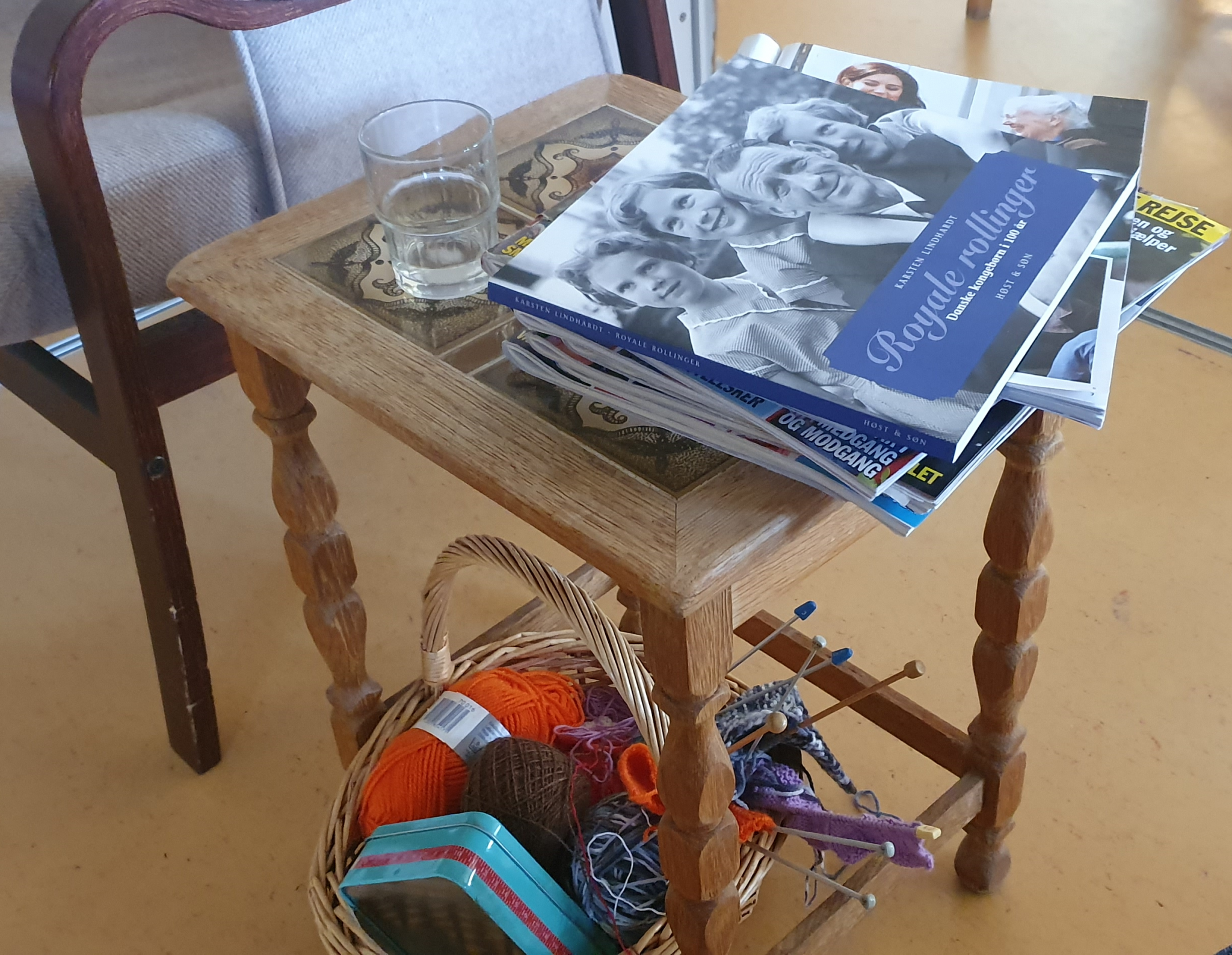
On our way back, we had a very interesting conversation in the car, about how the elderly are treated in different countries. Elena Floris told us that in Italy, most elderly people, especially the women, remain fully active family members, cooking and taking care of the grandchildren. In Poland, the system of social care is so bad, that the state-run nursing homes are the dreariest “death houses”, private ones are extremely expensive, the alternative being to hire a private carer who will live with the elderly person in their apartment, which is also quite pricey (the equivalent of an average pension).
We also had a debate about how to approach elderly spectators as artists. Just before the first mini-concert, someone suggested that the Winds should not sing with their full voices, in order not to overwhelm the spectators, especially those with hearing aids. So they sang very softly and, unfortunately, did not manage to strike the spark of connection with the audience.
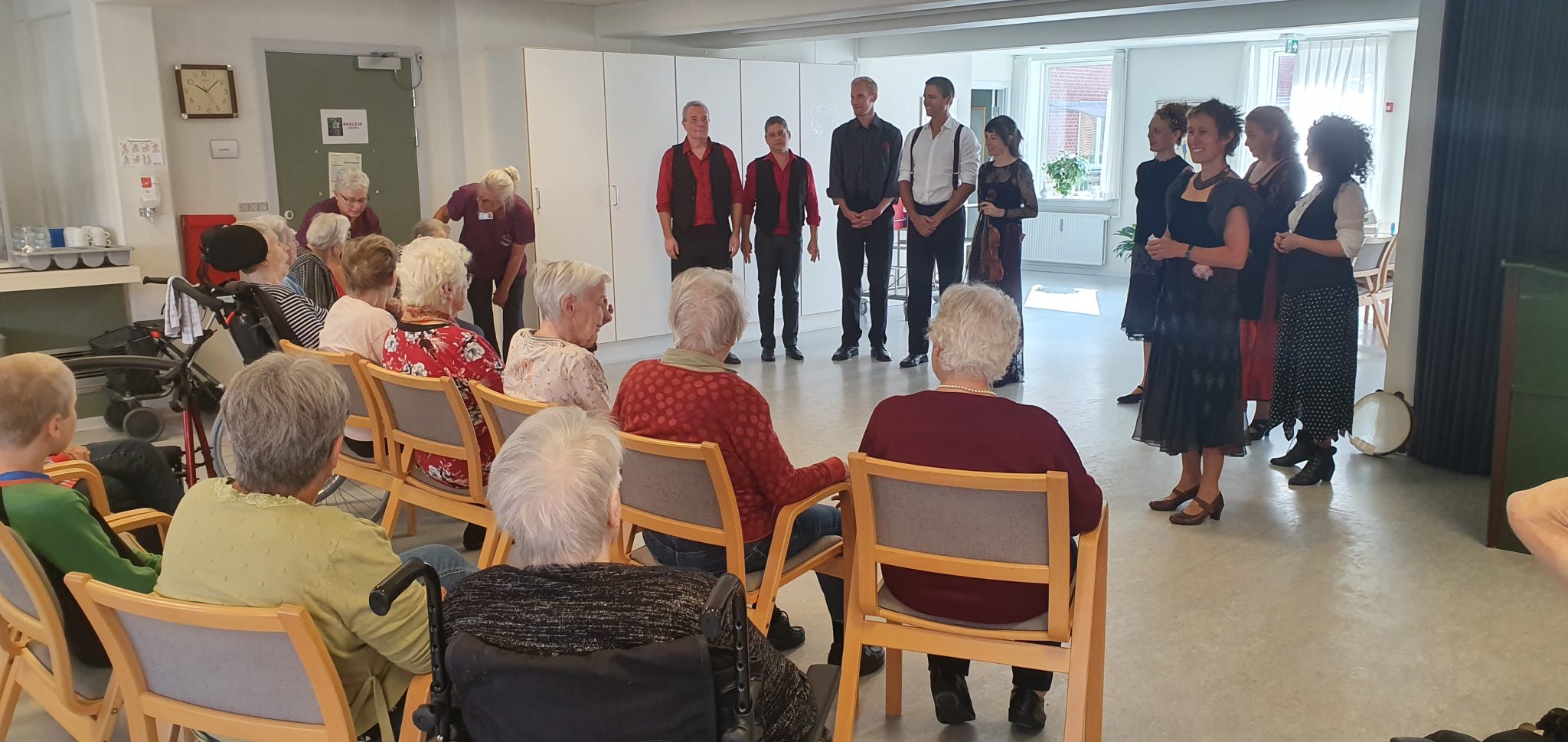
Then we discussed our different experiences with projects and performances in nursing homes, where the patients’ days tend to be very monotonous, they will not go out to the theatre or a concert, maybe an amateur group of children will visit them with some Christmas carols. A lot of the previous experience with projects in such places (also from talking to the employees and nurses) shows that one should try to avoid treating elderly spectators like children (even to the point of never using the kind of crayons they remember from school, when doing an arts project), but instead, talk to them about serious matters, in serious, grown- up ways.
And we came to the conclusion, that we should not try to “spare” them, but give them what they lack and miss – a full performance, a real taste of the Winds’ capabilities. That attitude resulted in a miracle in the second mini-concert: you could feel the flow of the energy and communication between the singing Winds and the audience.
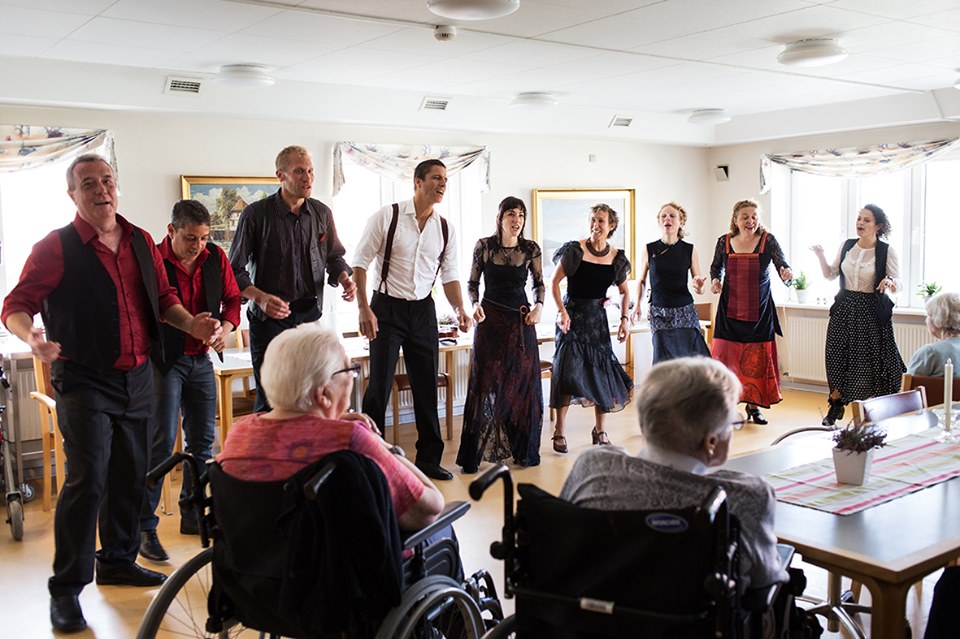
ON THE MOVE
And so we are on the move. Again. Packing all our luggage and bedding was a very organized chaos, even though, in the end, our car looked somewhat like a garbage truck.
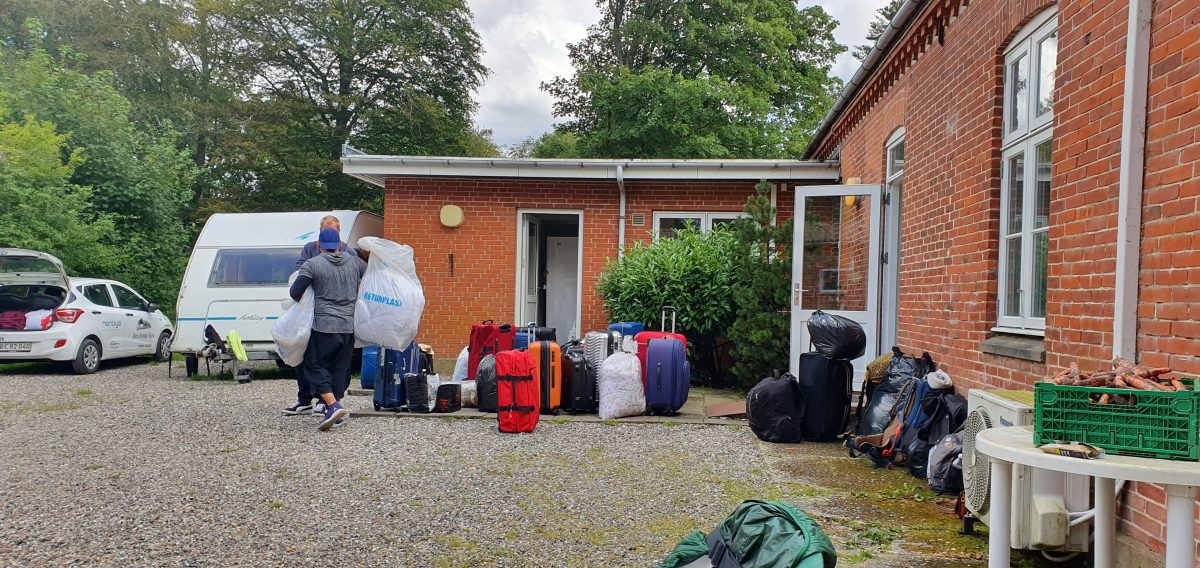
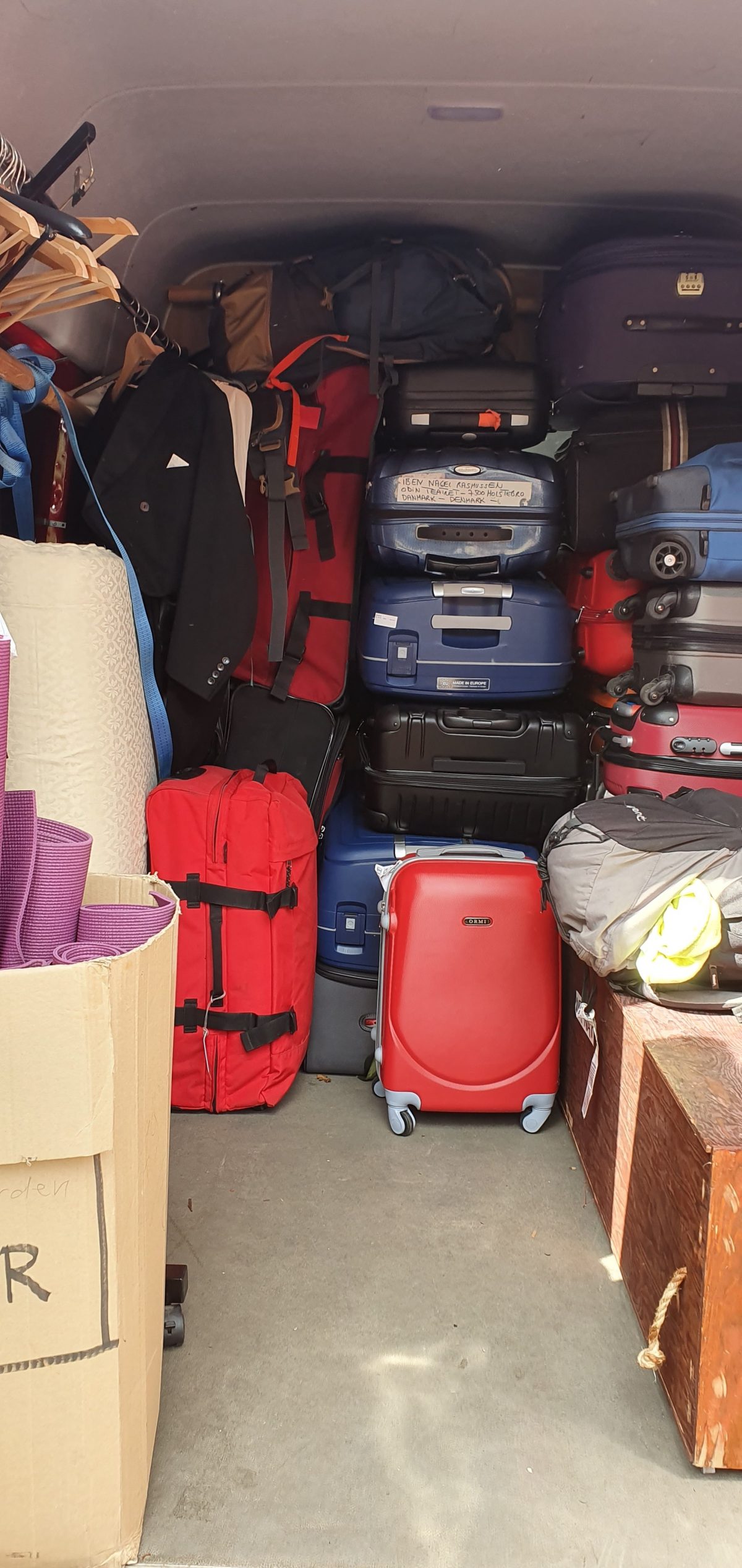
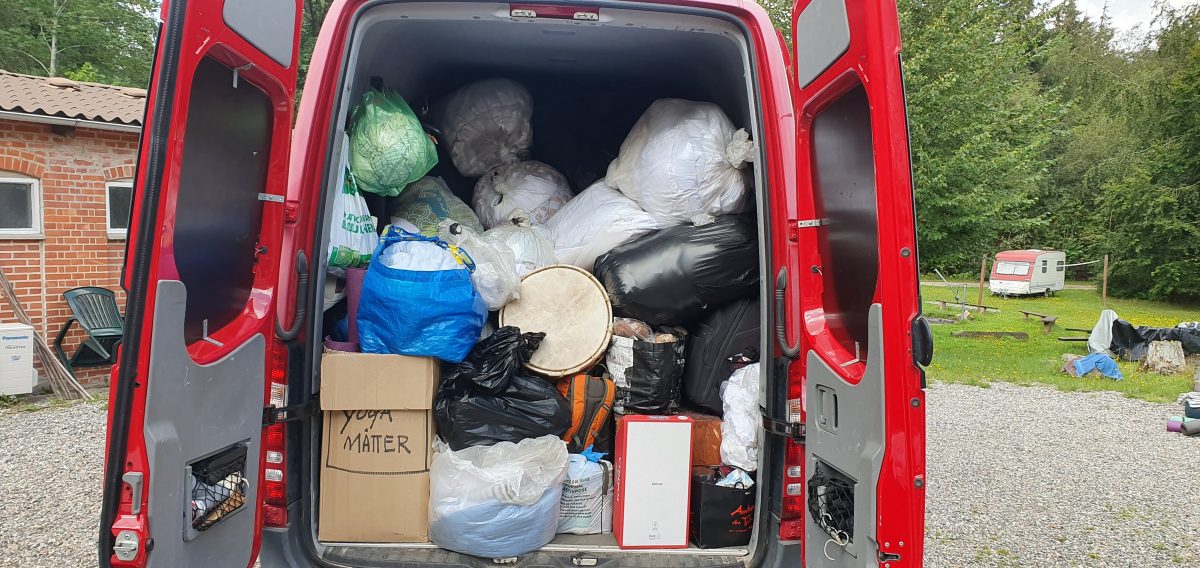
It was sad to say goodbye to the beautiful wilderness of Ulfborg, with its forests and meadows of heather and fireweed, and change into a much more rural environment.
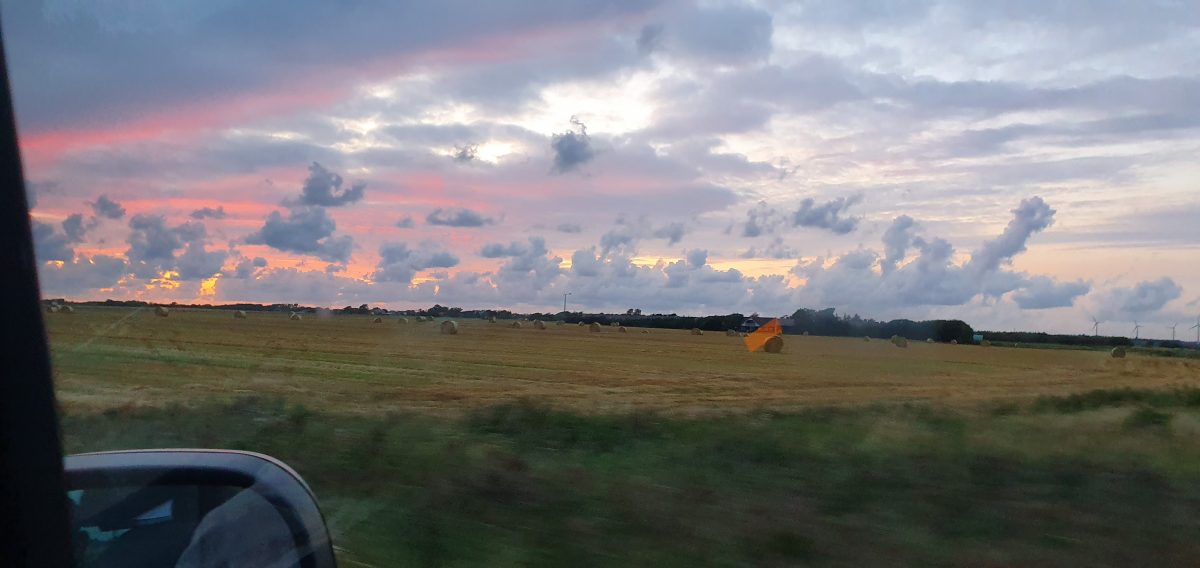
But we were not sorry to say goodbye to the communal showers of the Kronheden school campsite. Especially, after we saw our new showers…
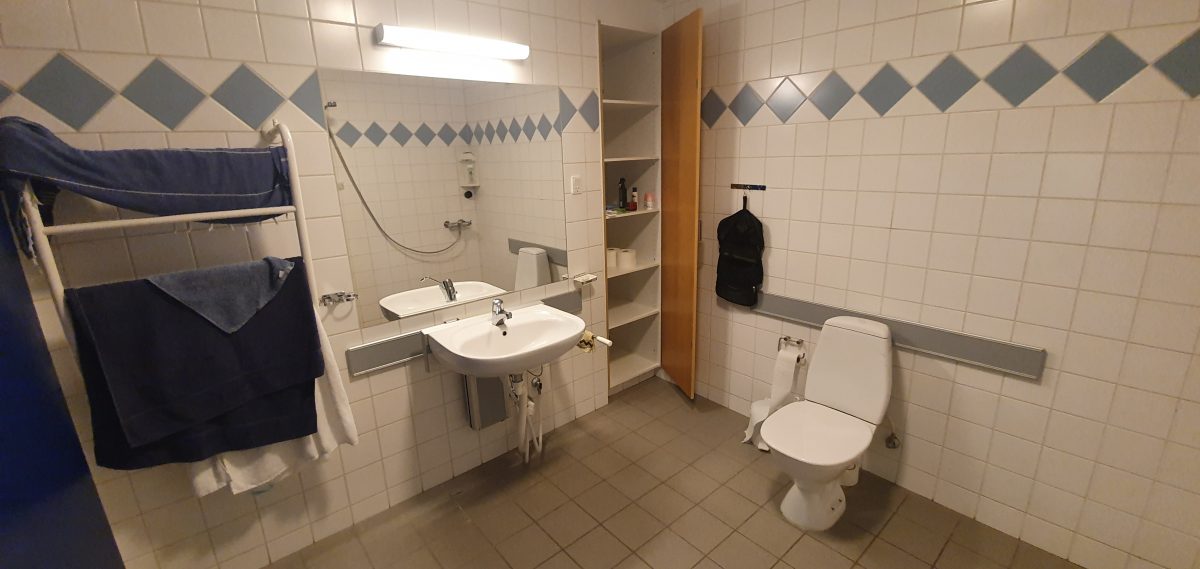
… and rooms…
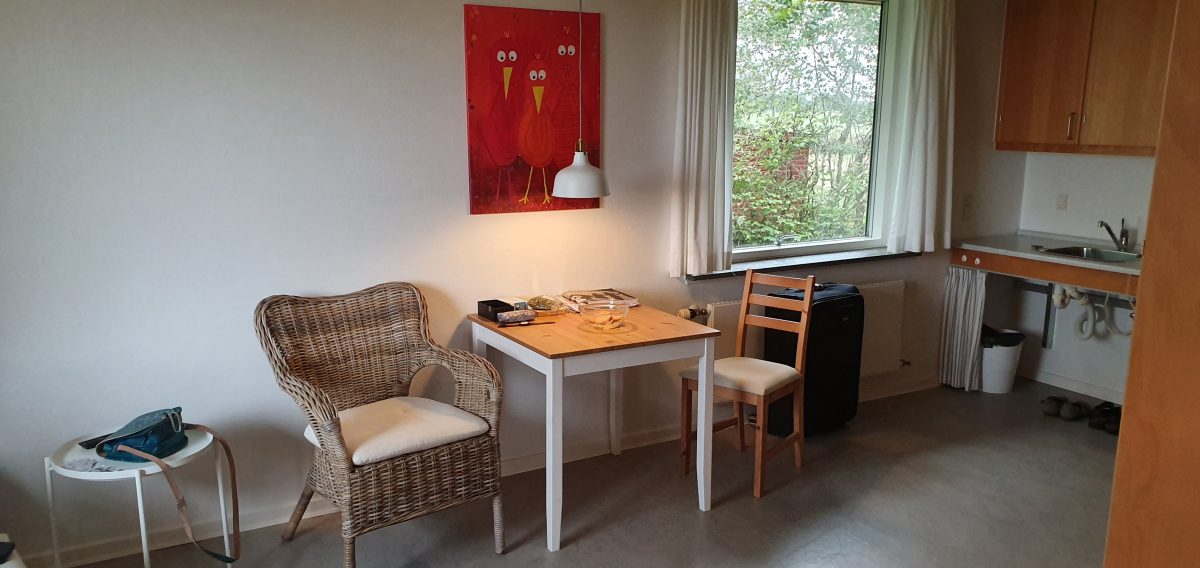

…and the view outside our windows…
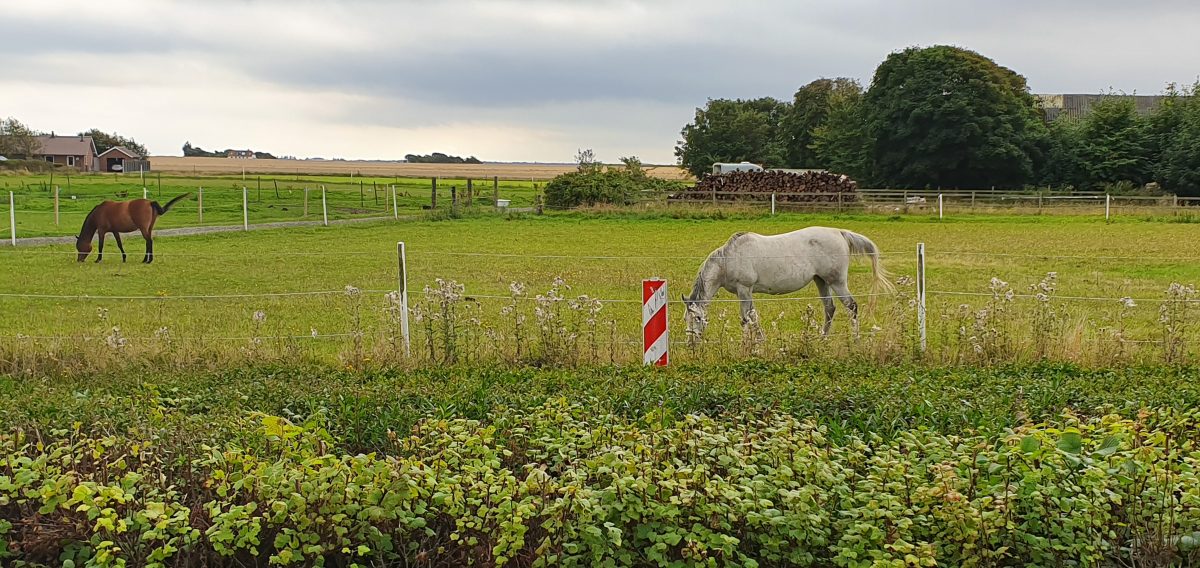
…and your bloggers’ new “hygge” office.
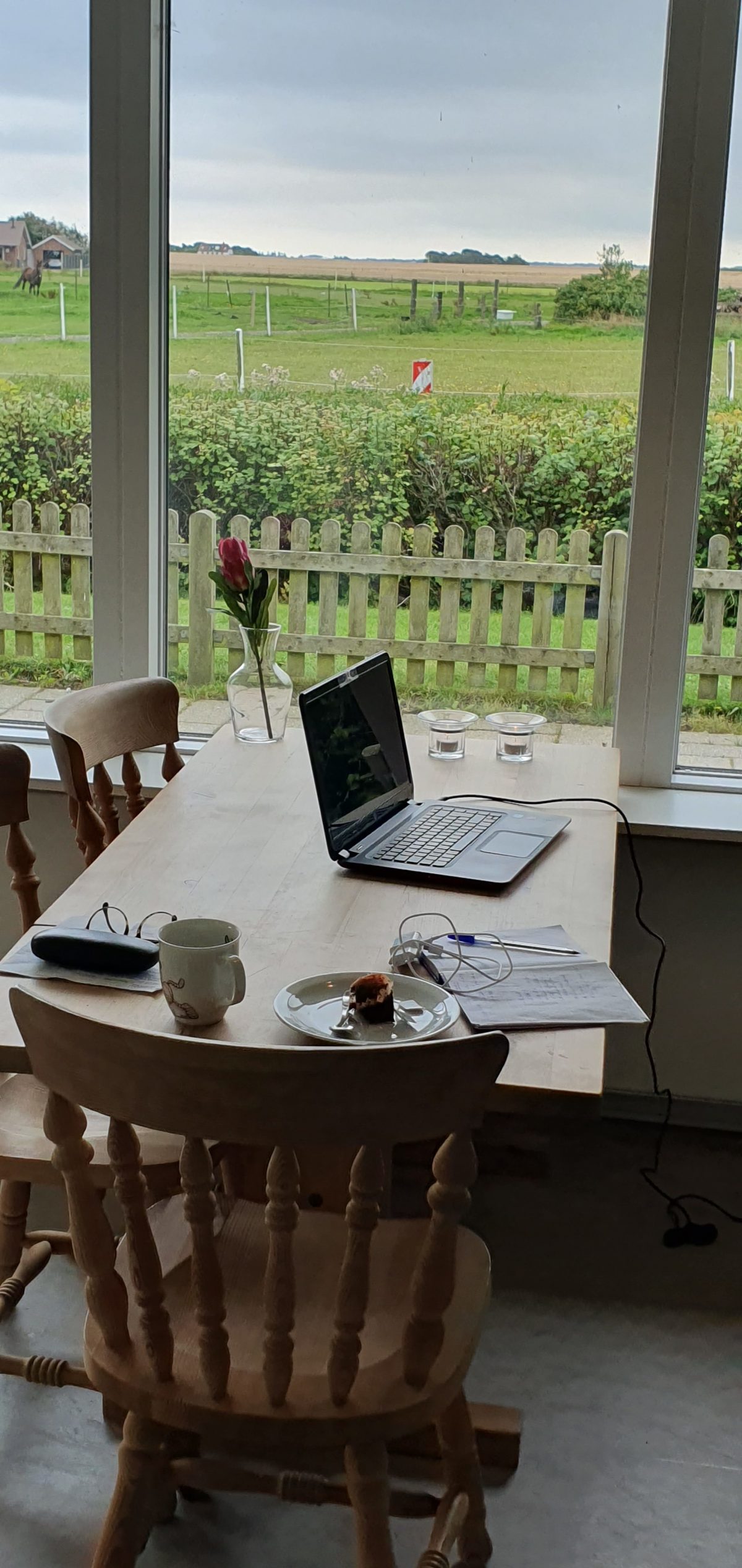
Unfortunately, there is a deeper and darker story to our beautiful resort. It has been converted from a nursing home. It is the municipality’s policy now to close down those small, local nursing homes we liked so much when we visited them with the songs the other day. To make elderly care cheaper, the inhabitants are moved to a bigger facility in town – far away from their families and the landscapes they know so well. And the buildings are rented out to serve, for example, as hotels.
PERSEVERANCE
On Tuesday, August 13, 2019, we celebrated the 30th anniversary of Teatret OM. It was held at the Vestjyllands Kunstpavillon (Western Jutland Art Pavilion) in Videbæk.
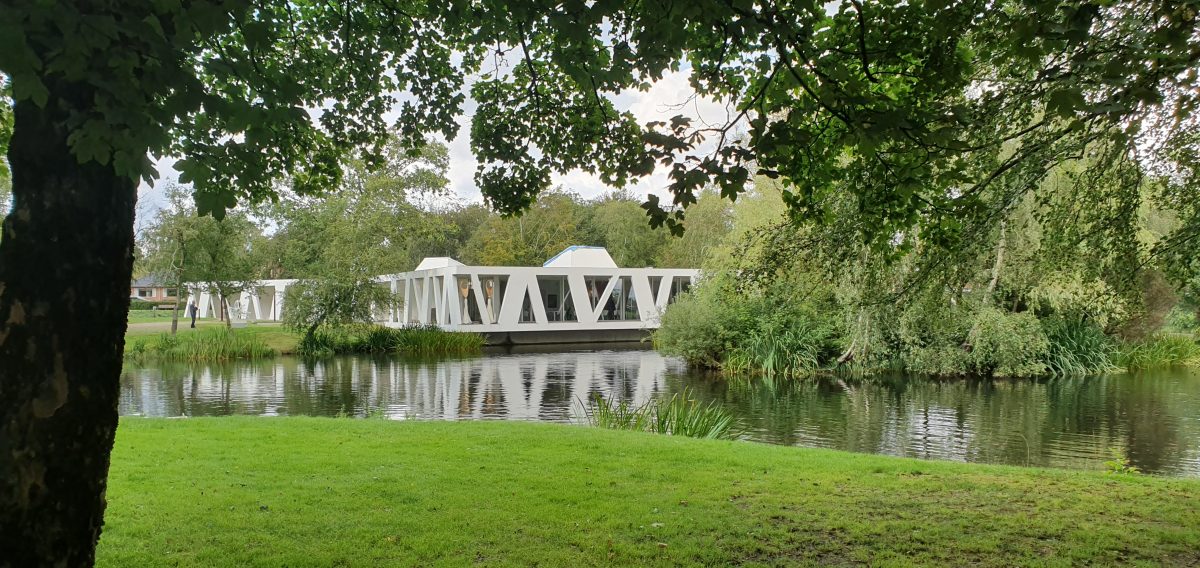
It consisted of an exhibition of Teatret OM’s set design by Antonella Diana and several outdoor performances (including an appearance of the Winds) in the park surrounding the pavilion.
In her speech opening the exhibition, Sandra Pasini stated perhaps the most fundamental truth about theatre: “Sometimes I wonder how we have managed to survive as Teatret OM for thirty years. Well, we have managed, because we never gave up, even when things seemed to be very difficult.” Being a performer, Sandra preceded her speech with a song, which spoke for itself and was followed by a flood of tears in the audience.
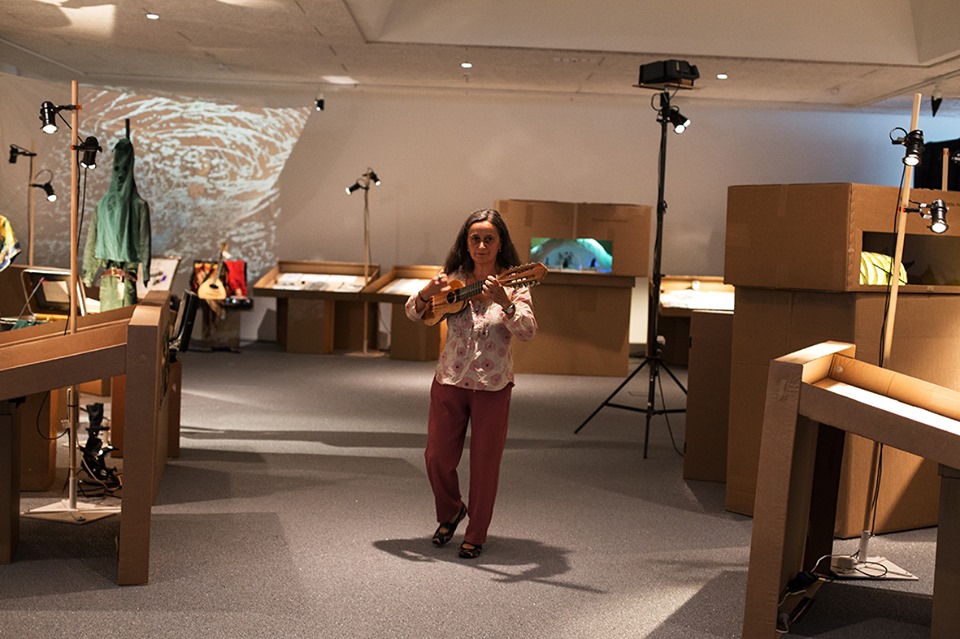
The exhibition itself was created by Antonella Diana and a young artist, Sara Holm Strandby, who had participated in a poetic performance by Teatret OM, “Times in the Wind”, in which old people were telling stories, and children wrote their dreams for the year 2020 and placed them in a black box, which is still to be opened next year. The project took place twenty years ago, in the town of Vinderup, which was Teatret OM’s place of residence at the time. Sara was twelve then and participated in the project as one of the “Dreamers”. Now she is a grown-up artist. In her opening speech, Sandra Pasini said: “If the work we did during the ten years in Vinderup could encourage a child to study art and come back to her small town with a wish to make a cultural project, then our work has accomplished its goal. The story of Sara really shows that art and culture have the power to encourage a child to believe that their dreams and passions can come true.”
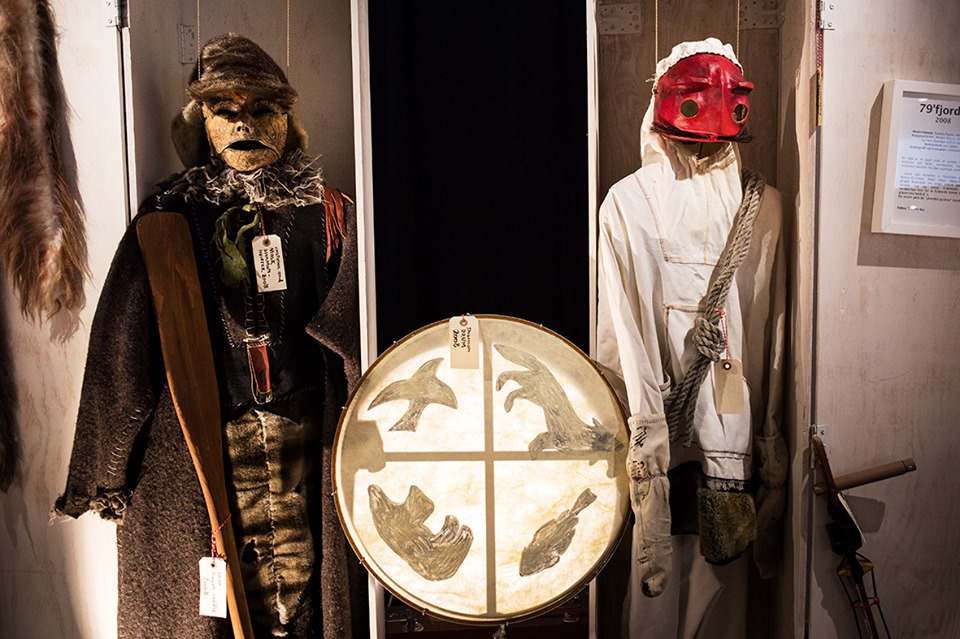
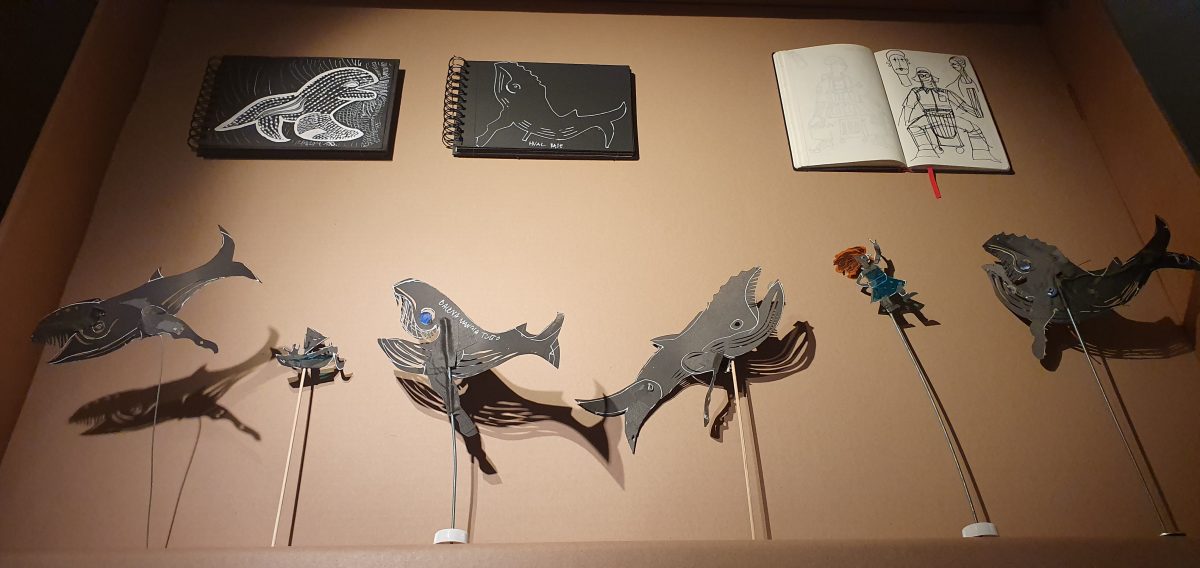
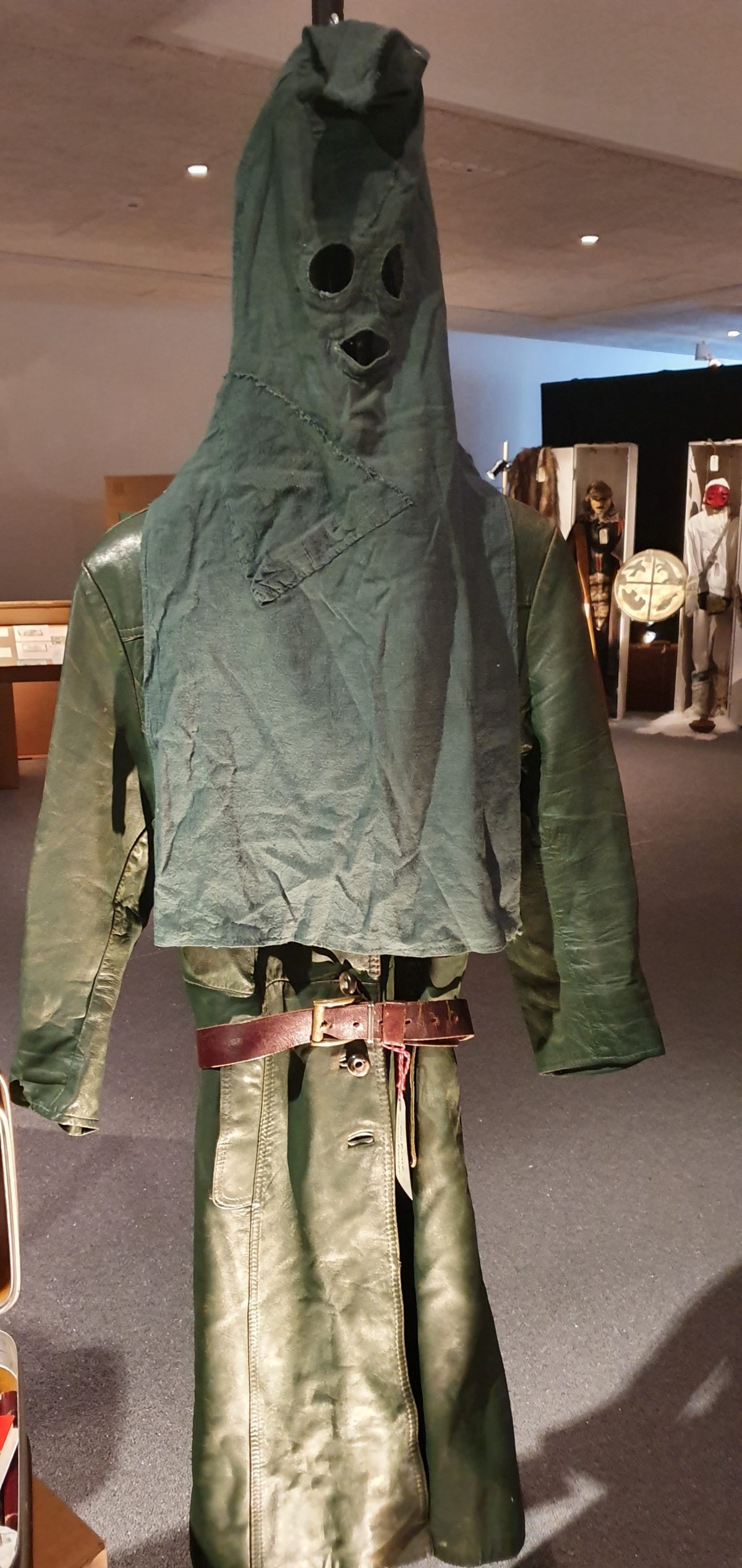
In the letter Sara wrote to Teatret OM congratulating them on their anniversary, she said: “In the four performances the exhibition is comprised of, there is a constant concern with solidarity between human and nature, and between human and the material, all matter is unified. We, as humans, belong to nature, as nature.”
On that note, all the small performances that accompanied the exhibition, were either concerned with the theme of the environment, like the conceptual installation-performance involving a dancer and styrofoam-eating worms, entitled “MASS – bloom explorations”…
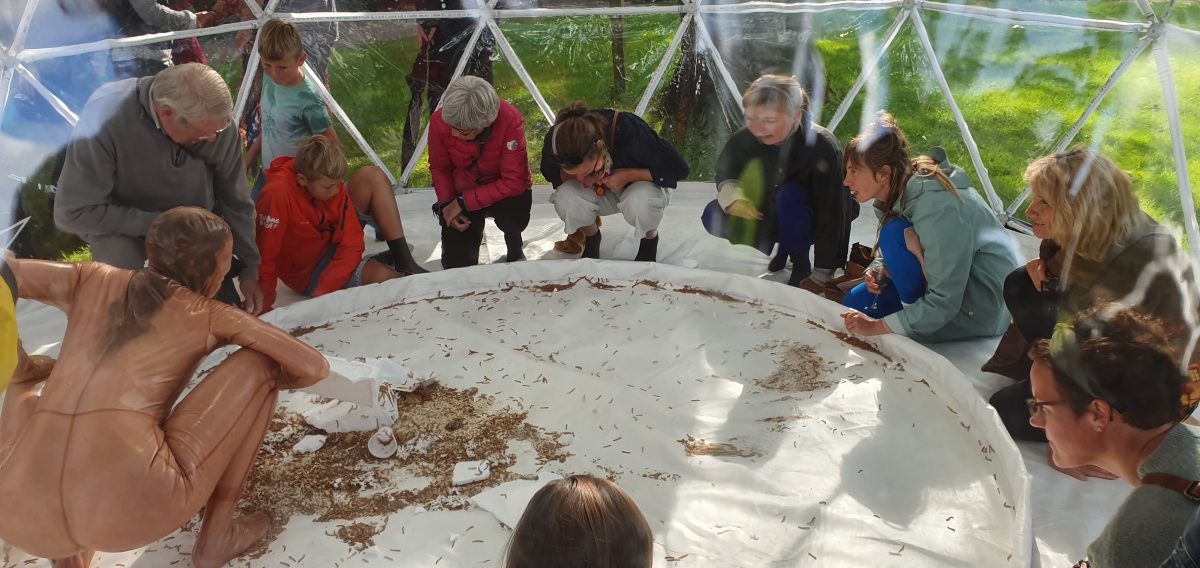
…or using Nature as a performer, like Jan Ferslev and Rachel Rosalen did in their musical installation “The Wind Sings”, composed of wind harps, where the wind plays on the strings:
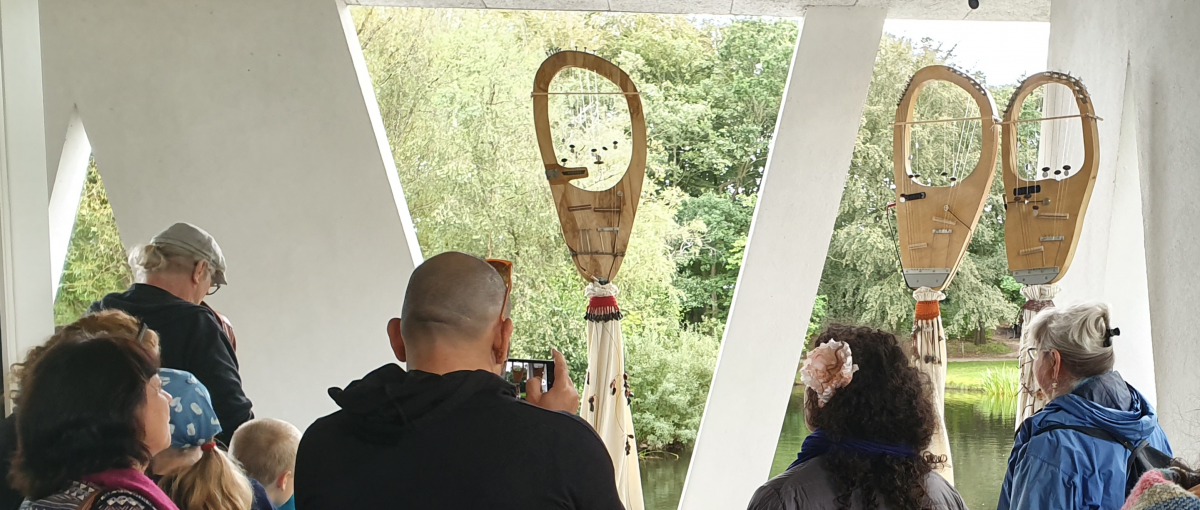
…or making a dialogue with Nature, like the performance “Letter to the Water” by a former Teatret OM actress, Hisako Miura, in which the spectators were encouraged to write a message to water, which is disappearing from Earth due to climate change. The messages were written on colourful ribbons, which Hisako then took to the pond on a raft.
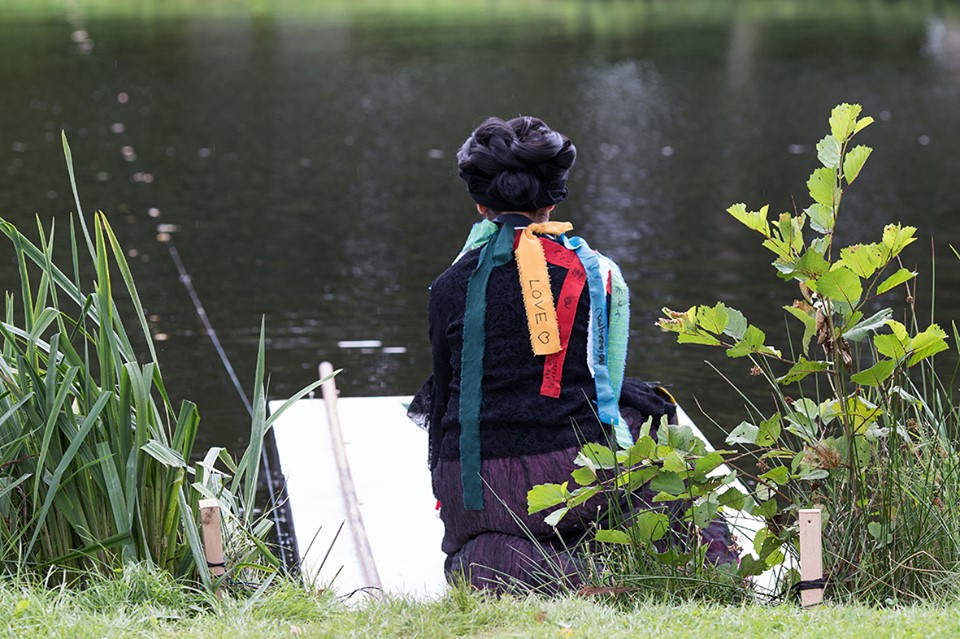
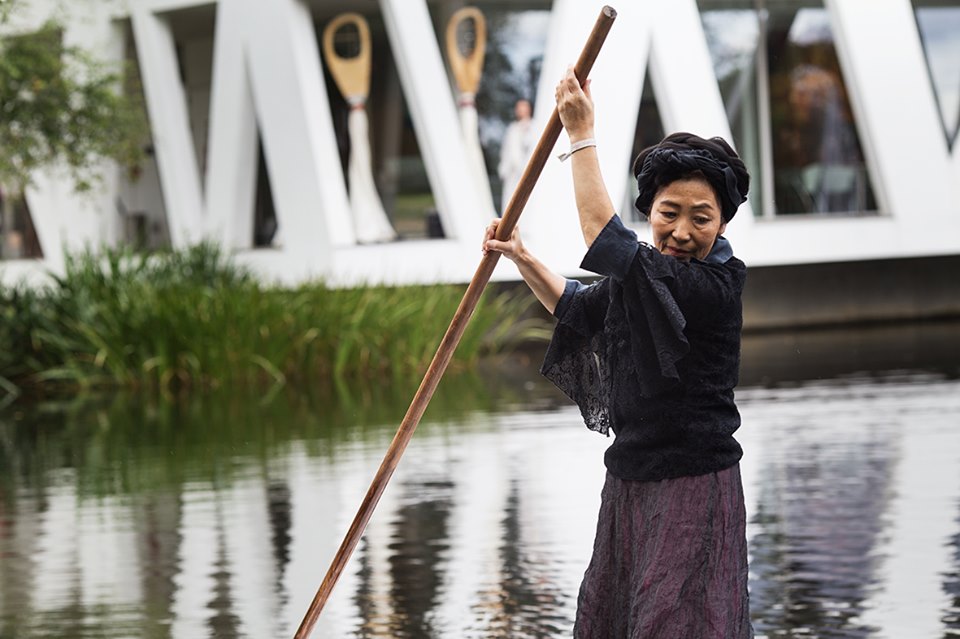
Some were composed into the architecture of the Arts Pavilion and the natural landscape of the park, or made sometimes very theatrical, and sometimes very human, contact with the spectators. And that was The Bridge of Winds.
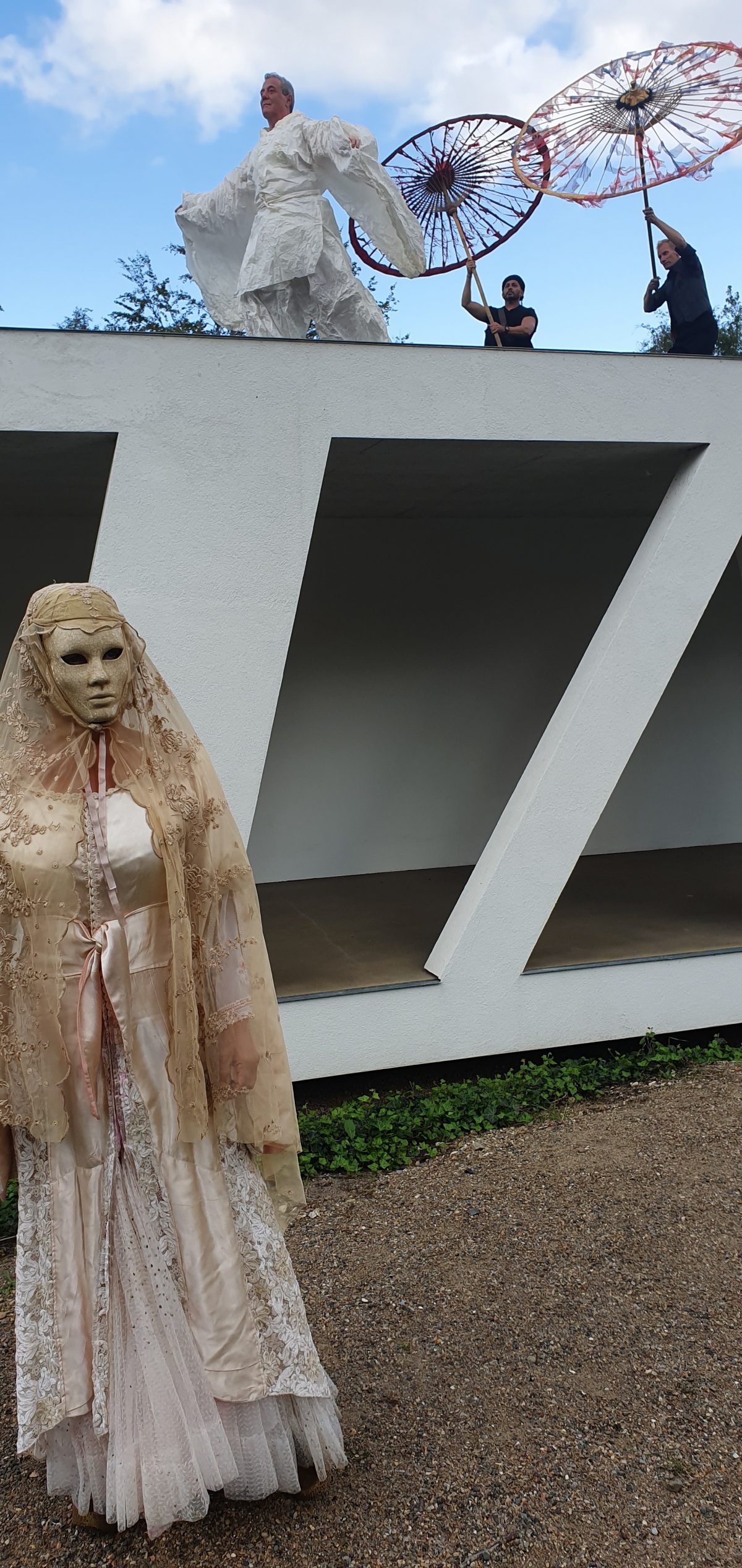
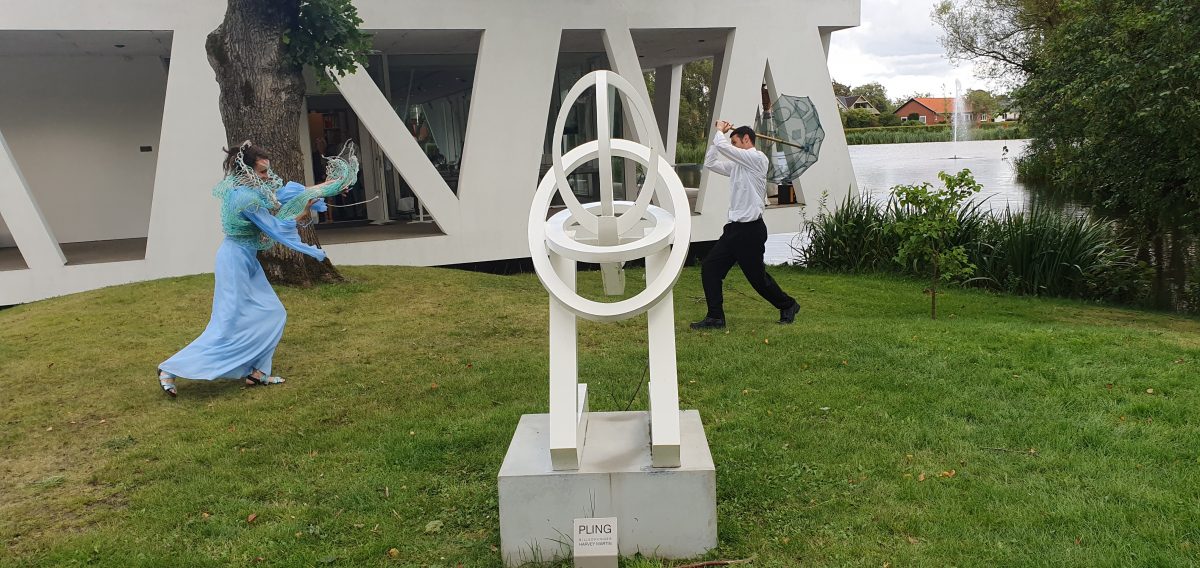
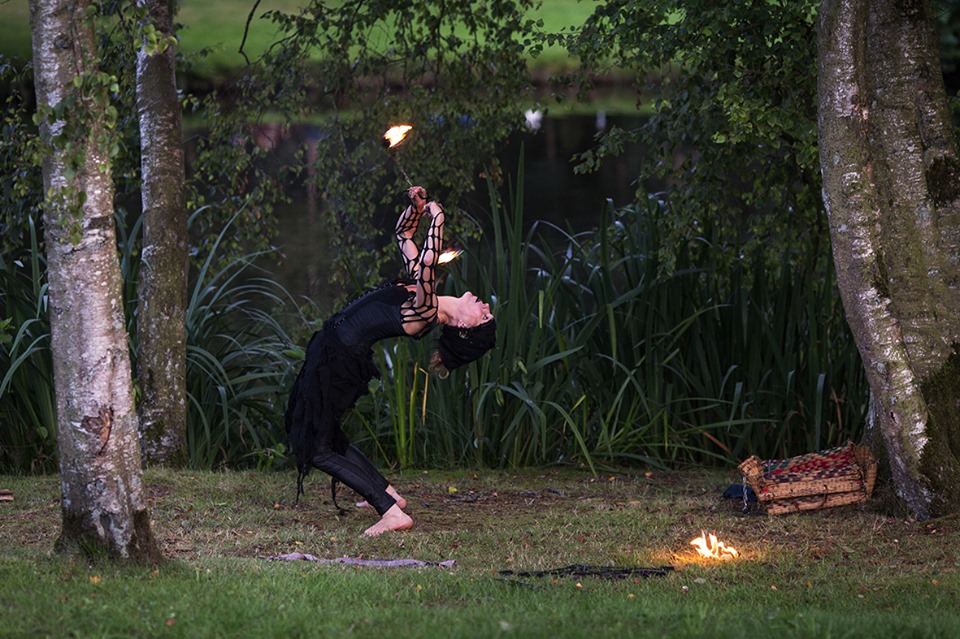
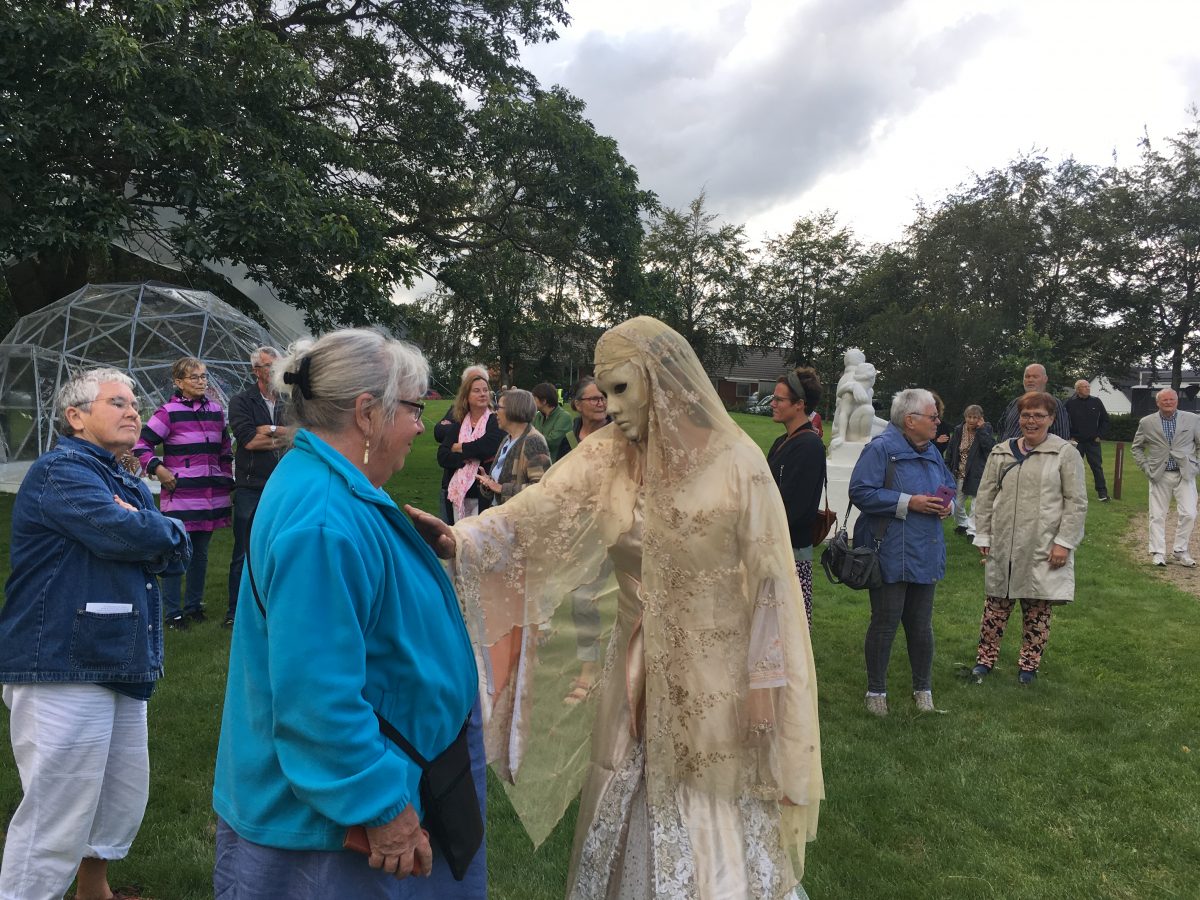
EXCHANGE OF TRADITIONS
No, it is not a post about a barter. It is a food post!
We must have at least one food post during each meeting of The Bridge of Winds. And in this case, the food was so amazing, that I want to write more than one…
In Videbæk, we got a conference room to use as our base for the day at the Westergards Hotel. Once we got there, there was live music at the door and a red carpet. We got all excited, but it was not for us… It was just a wedding. The hotel has exquisite cuisine and is used for many local celebrations.
During our numerous meetings in Denmark, we have learned that it is a tradition here for the chef to come and personally present the food, when there is a buffet-style meal. And so it happened at the hotel, as well.
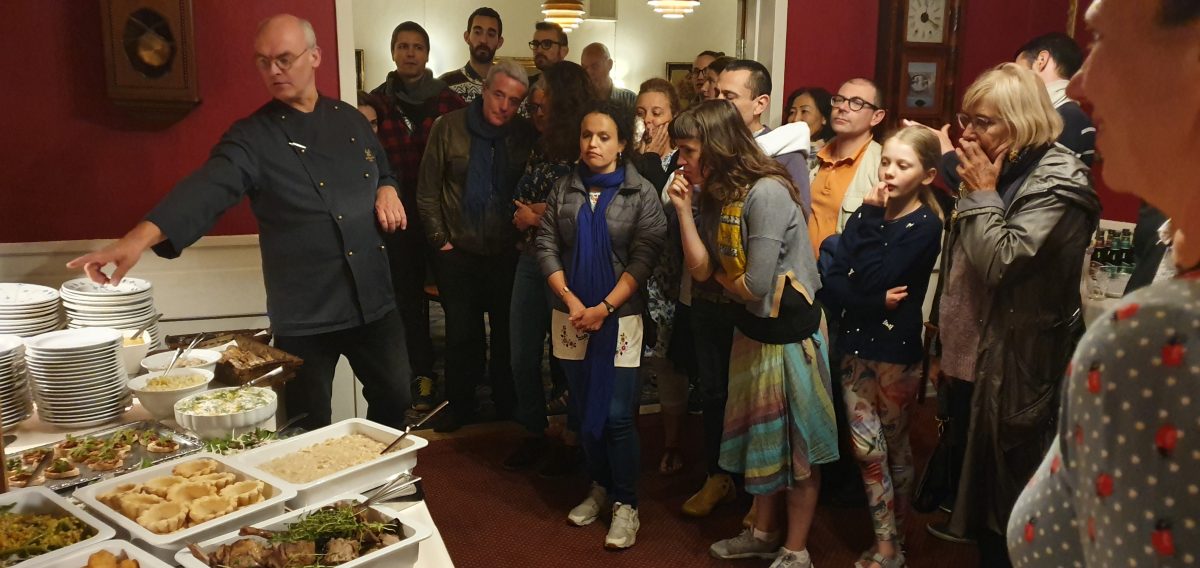
The menu included roast duck and pork with plum sauce, made from fresh plums from the chef’s own garden, a vegan curry, shrimp and potato salads, traditional Danish tartelettes with a creamy chicken filling, and crabmeat soup. Crabmeat. Like in a gourmet restaurant in Alaska or somewhere…
The chef had every right to be proud and the Winds were so happy with the delicious feast, that they called in all the cooks and thanked them with a song, which is a very long-term tradition of The Bridge of Winds.
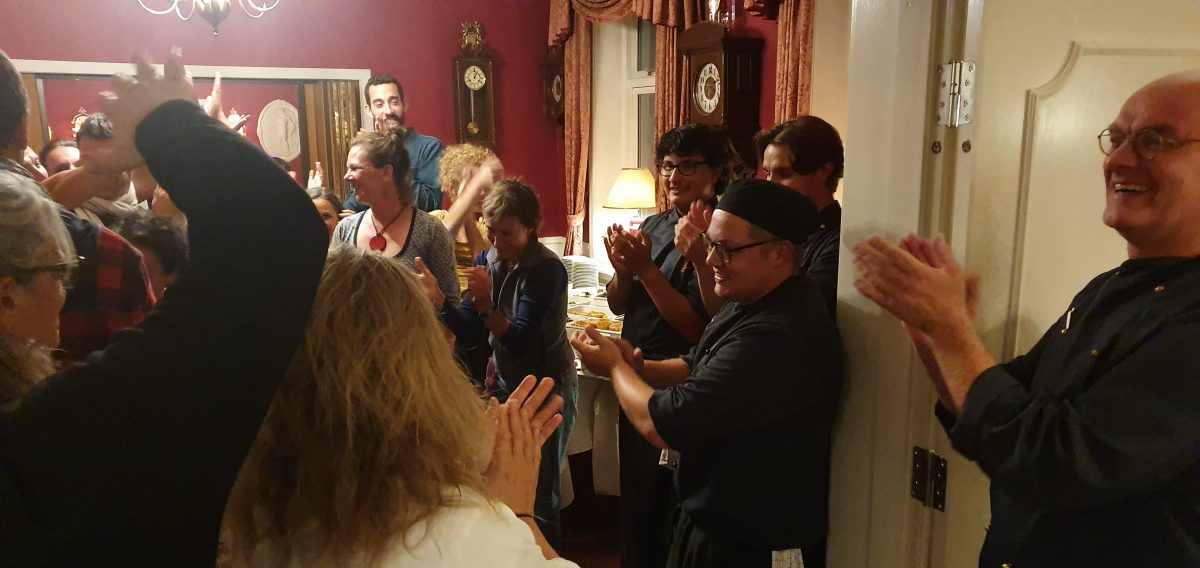
Actually, at every place where we ate, the cooks got a thank-you song from the Winds. Especially at Teatret OM, where the food was prepared by local volunteers and was absolutely wonderful.
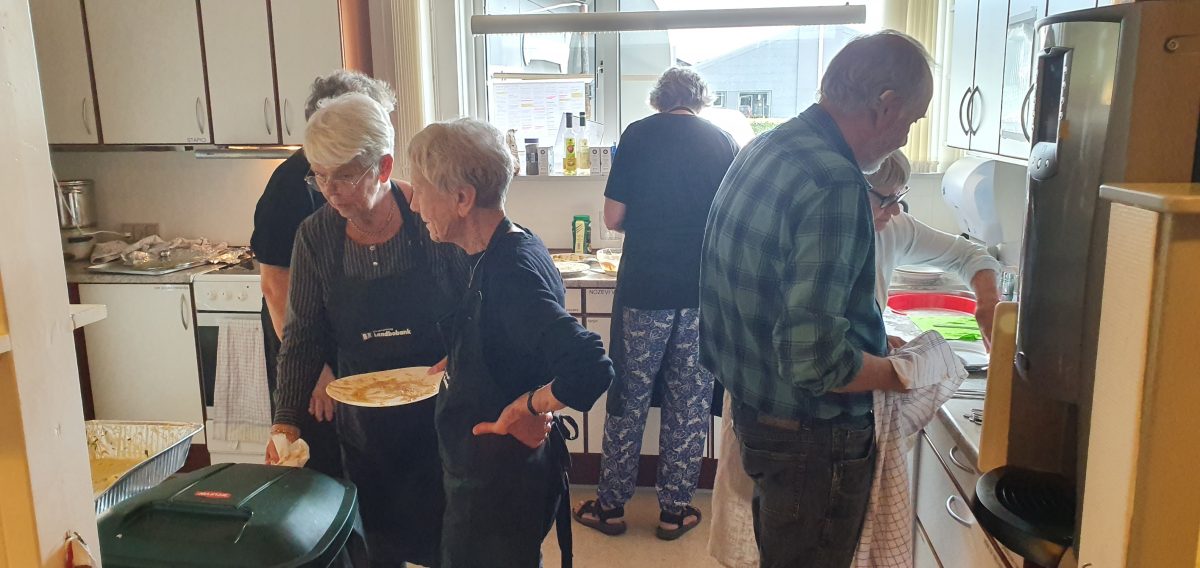
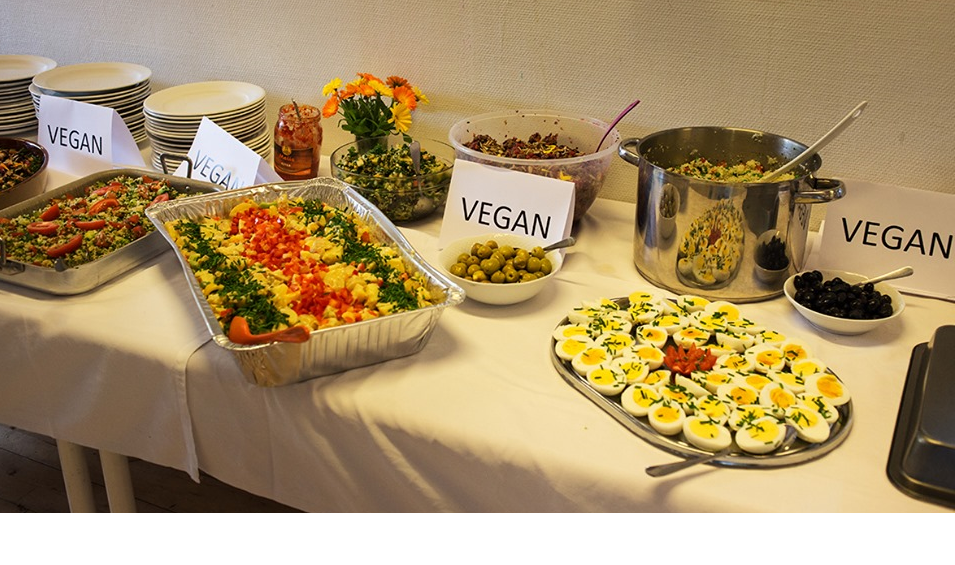
“CULTURAL RIVER”…
…is what Teatret OM decided to name the parade, directed by Leo Sykes to celebrate its 30th. anniversary and the beginning of the festival. It began at the city hall, with the Winds suddenly appearing in the windows, with calls and songs.
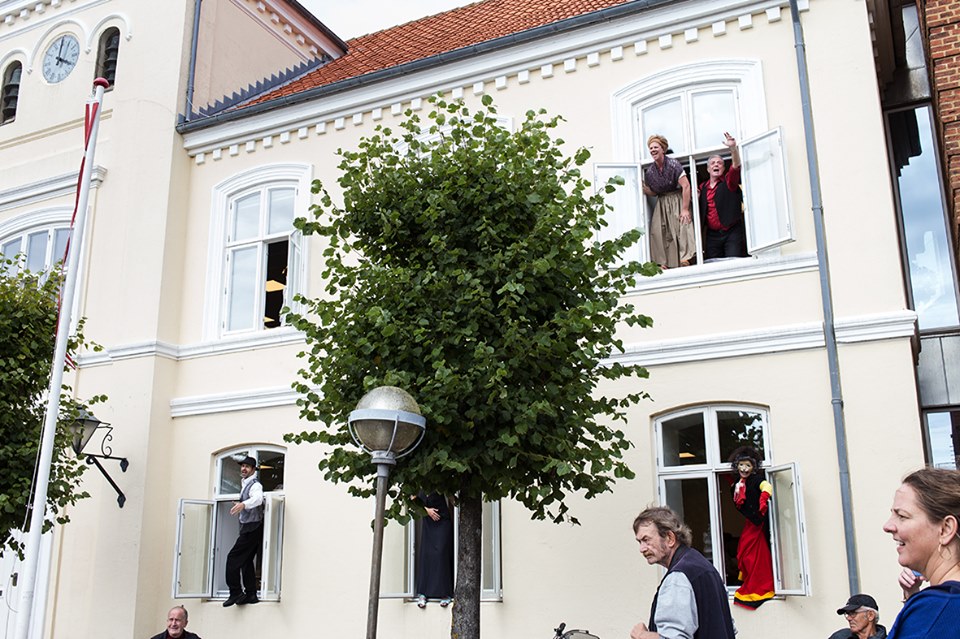
They finished by throwing some oranges to a couple of jugglers from the Gandini Juggling company, who then took over the show on the square. Their prestidigitations were followed by a sequence of numbers by various invited artists, local kids, and the Winds. Even a representative of the municipality made a little performance: Mr. Per Høgh, who is in charge of culture in Ringkøbing, appeared in a top hat decorated with colourful flowers, to express the town’s wish for Teatret OM to remain there for at least fifty more years.
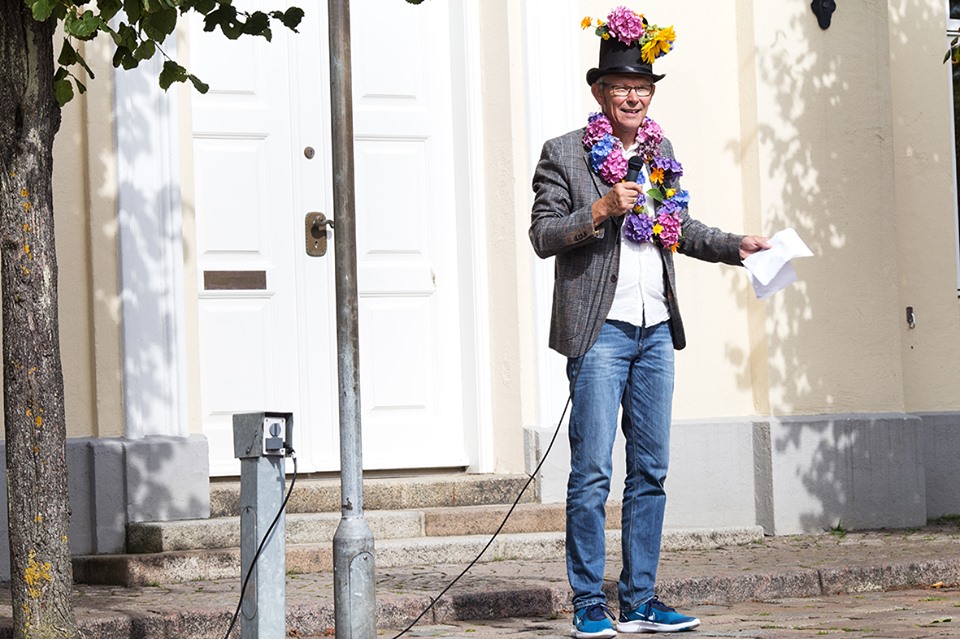
Then, the river of spectators, performers, characters, musicians, children, and even dogs flowed from Ringkøbing’s main square to the port. Many local people, as well as a couple of characters from the Winds, greeted it from the windows.
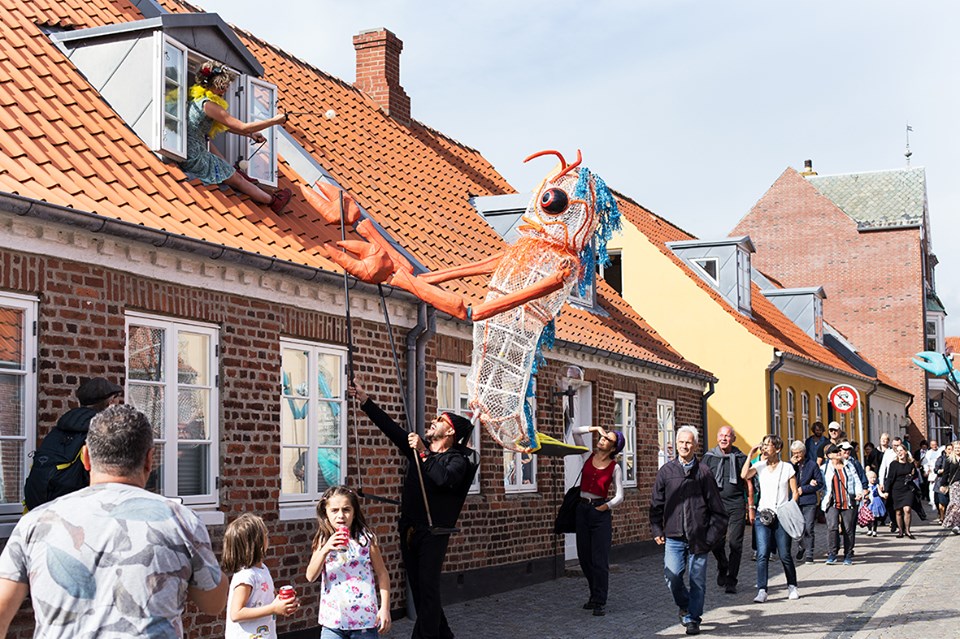
At the port, the performance continued. First, with three couples dancing simultaneously: Hisako Miura with Eveline Costa, the two jugglers, and Adriana La Selva with Marcos Koslowski with their fishing scene. Then the Winds with a street/clown version of one of the songs from the Concert, then Teatro Tascabile with their eternally amazing waltz on stilts, followed by the Winds’ Wheelchair Dance, created back in 2005 for the performance “Ancestors”, with Signe Thomsen and Mika Juusela. Thus, the mood went from festive to pensive.
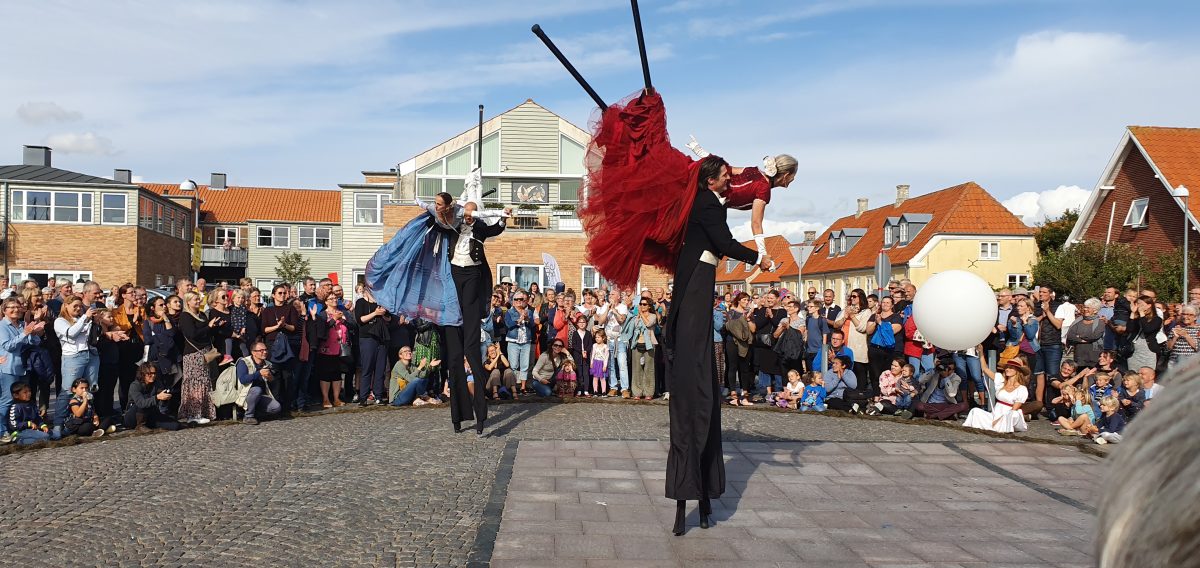
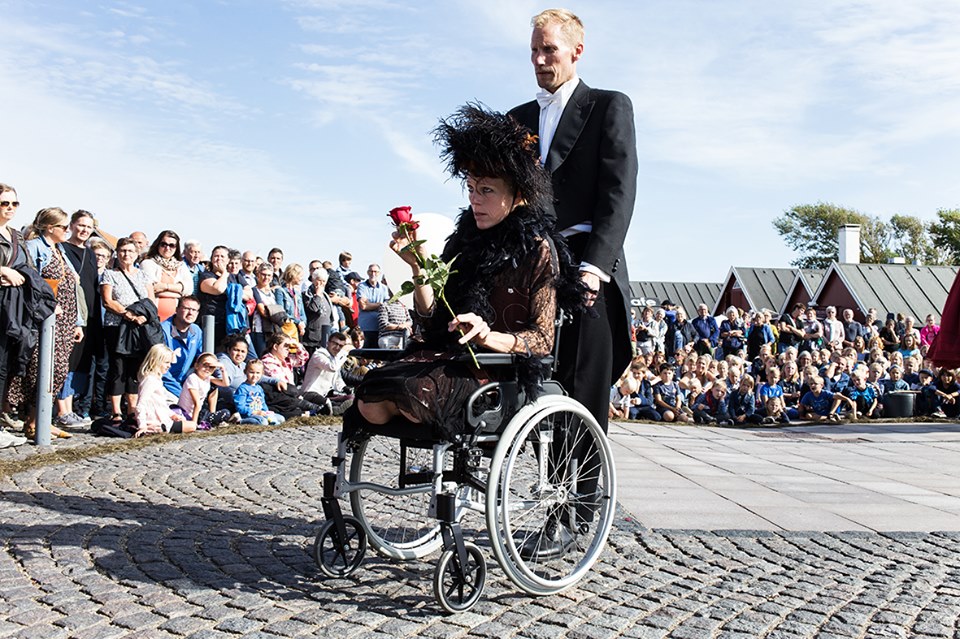
Then we heard Guillermo Angelelli’s horn from the pier. Everybody turned to face the water and saw two boats, carrying the characters of Carlos Simioni and Tatiana Cardoso.
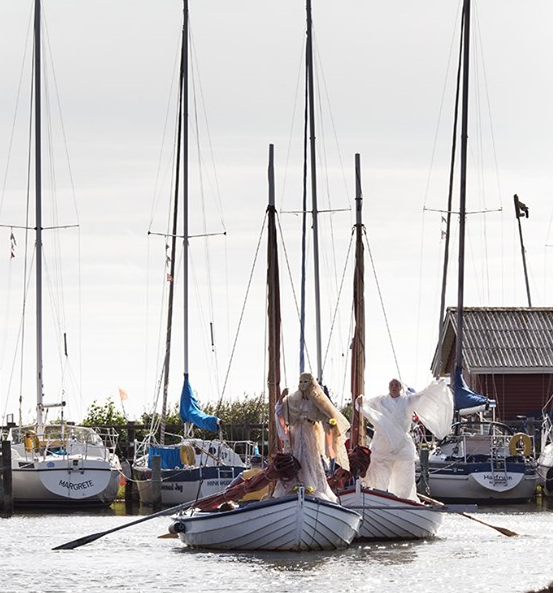
According to the director, these were Neptune and Iemanjá (an Afro-Brazilian orisha goddess of water), looking for their daughter, the Mermaid. And she suddenly appeared – a young woman, running towards the pier, as if she wanted to get to the sea before her legs become a fish tail again, taking off her clothes as she ran, to jump into the water and swim away, followed by the boats. The “Mermaid” part of the performance was accompanied by songs of a local choir and the Winds.
THE RIVER BECOMES A SNAKE
The Sunday parade in Hvide Sande was directed by Miguel Utreras, who presented his vision of it to the Winds on Saturday morning. It was a little performance of its own.
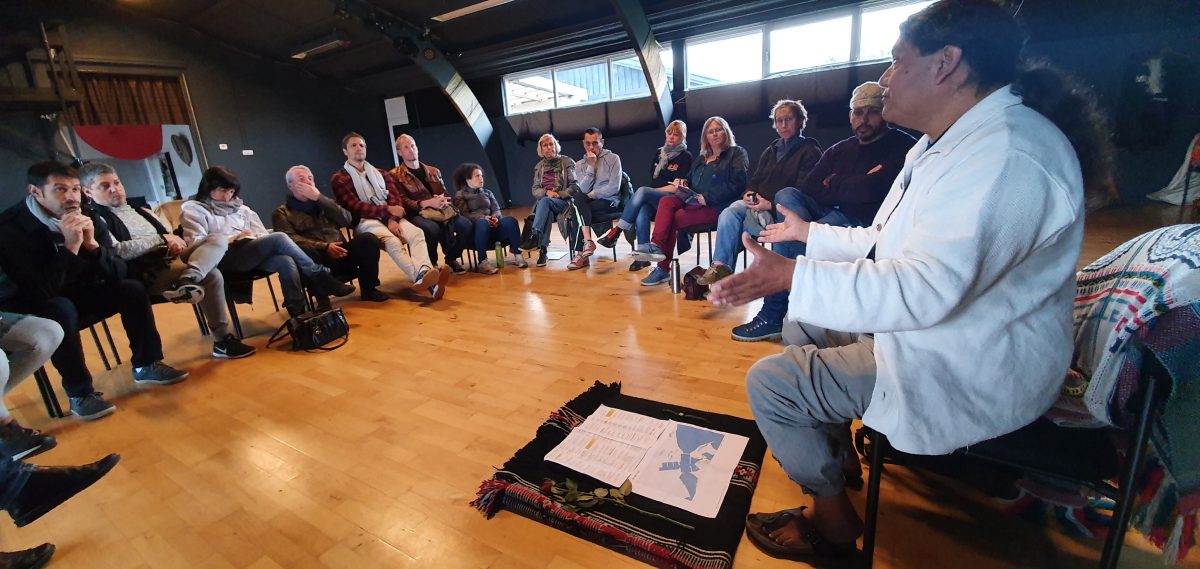
He based the structure of the parade on the cosmogonic system of the indigenous peoples of South America, which is composed of three levels. Read from the bottom to the top, they are: the energy of the land, the conscious, and the wisdom or enlightenment, while from top to bottom, they can be interpreted as the ancestors, the living people, and the children – the future. Those levels are connected by a snake, which represents Nature and in Latin American symbolic language is pictured as in the drawing Miguel made in my notebook:
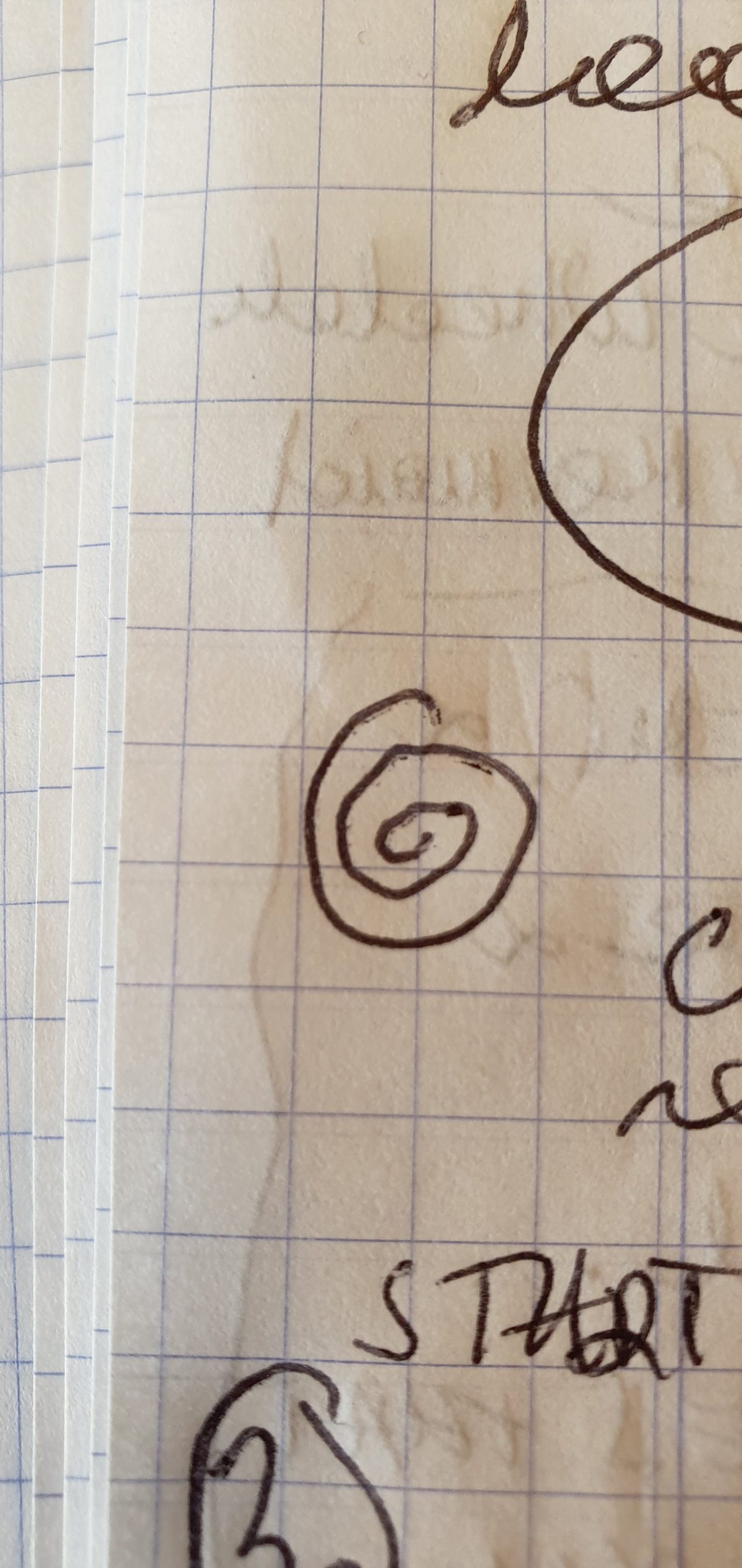
On one level, the parade itself became the snake, composed of three different elements related to the structure: it was led by the Winds, representing the Enlightenment, the middle was the children, and the whole parade was closed by two actresses from Teatro Tascabile – one on stilts, the other holding a balloon, so they looked like a mother and child.
Miguel admitted he decided to use the ritual structure for the parade, because he wanted to have some justification of the actions for himself and the actors, while for the spectators, who will never know that the indigenous story is behind the parade, it will have a totally different meaning.
Officially entitled “Kulturfangst” (Culture Catch, “catch” meaning the fish caught in a net), it started on a hill named Troldbjerget (Troll’s Mountain), overlooking the whole town of Hvide Sande and the sea around it.
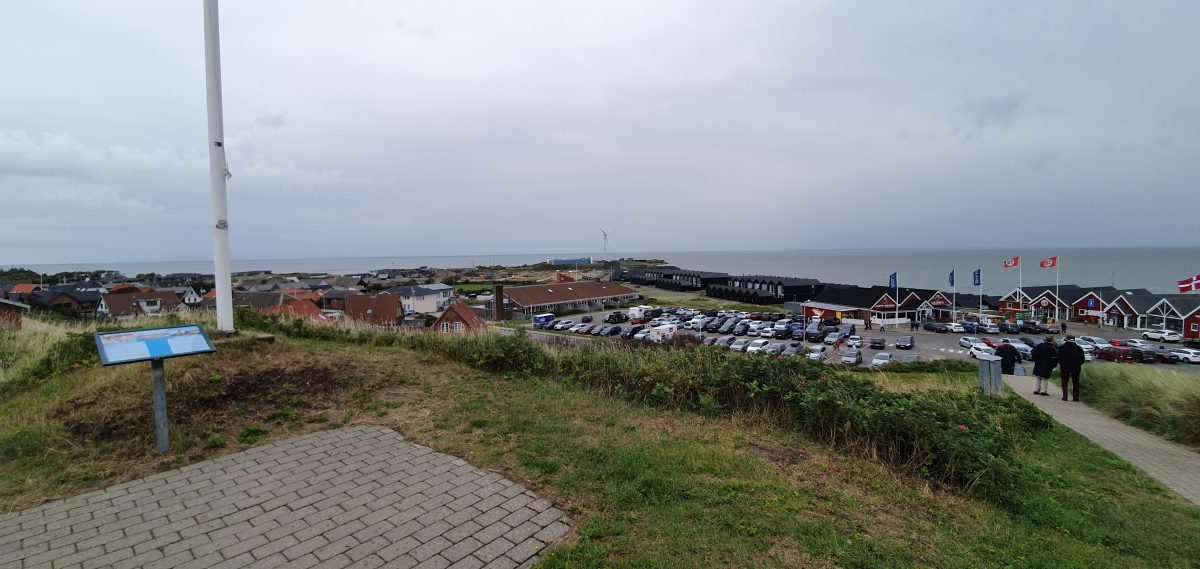
Hvide Sande, which means White Sand, is a fishing port and a tourist town, located between a fjord and the sea, amongst the dunes where people have their summer houses.
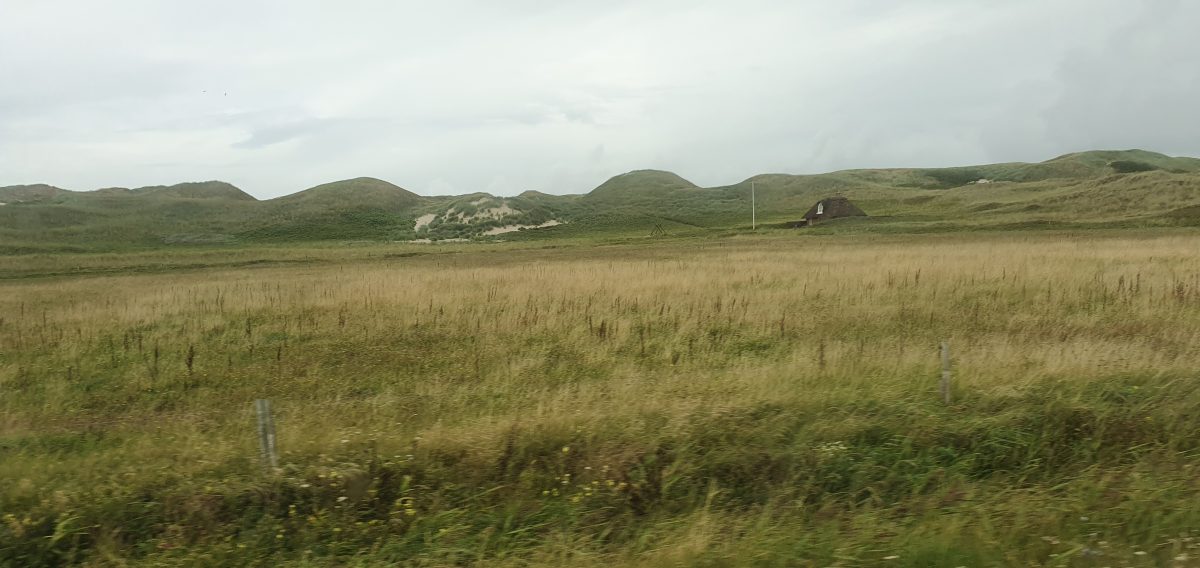
The participants of the parade were placed on Troll’s Mountain according to Miguel’s ritual structure: the Winds (the ancestors) at the top, teenagers (the living people) in the middle, and the smallest kids (the future) at the foot of the hill.
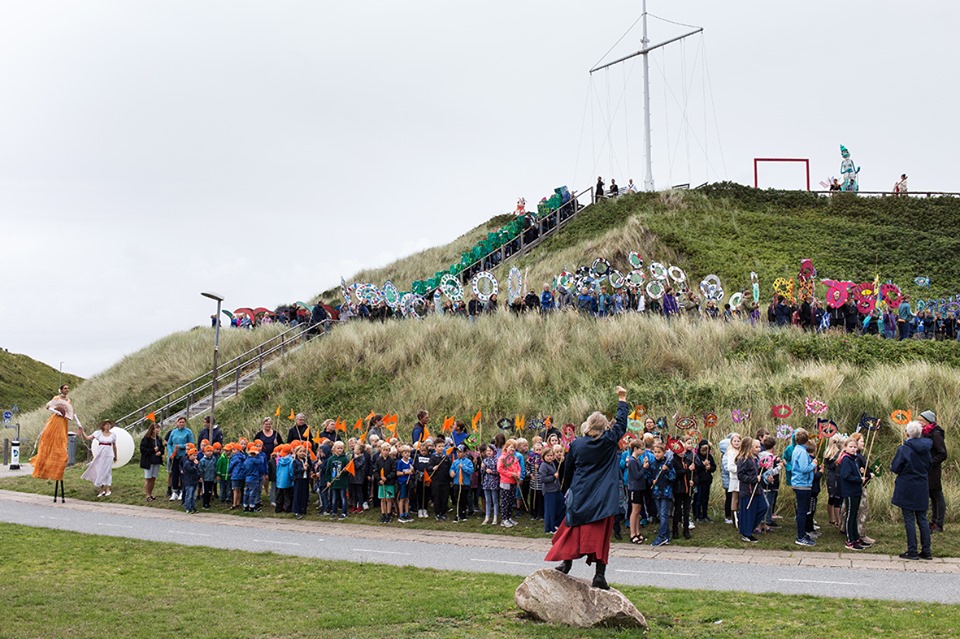
Those three elements were connected by the snake, composed of about twenty segments, created and carried by the children.
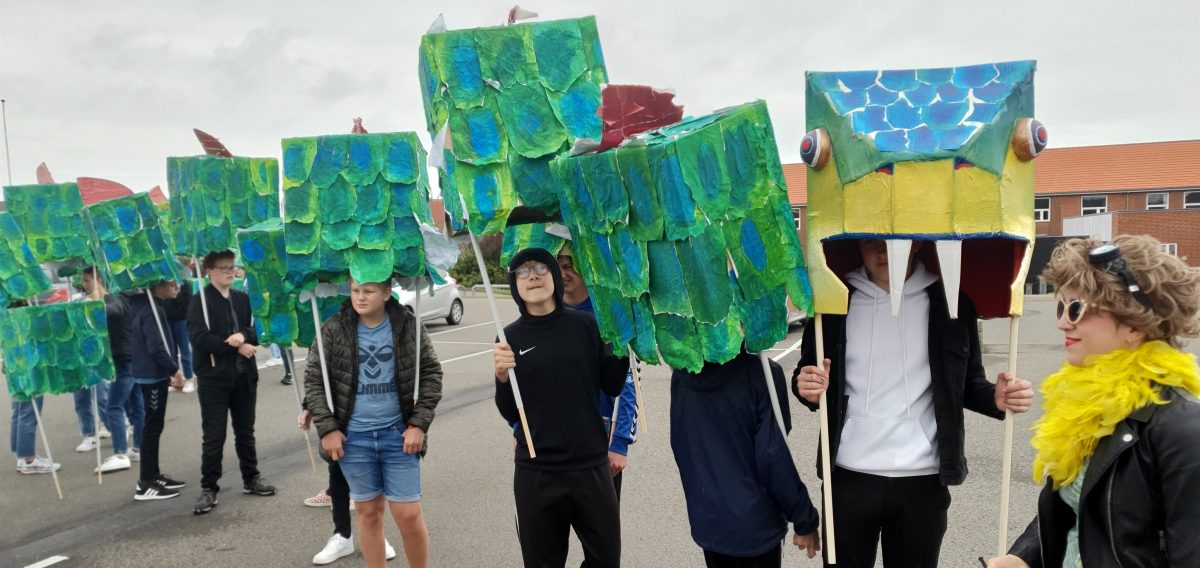
The snake, as well as all the other things carried by the children in the parade, was made in June, during a workshop Tippe Molsted and Teatret OM did for the 300 kids of Hvide Sande Skolen and Fjordskolen.
The children also learned a song about sea pollution during the workshop, which, along with the parade structure, was practised every morning for three days, under the supervision of Miguel and Pernille Abildgaard Ullmann, who – very obviously – had the time of her life babysitting hundreds of kids at dawn.
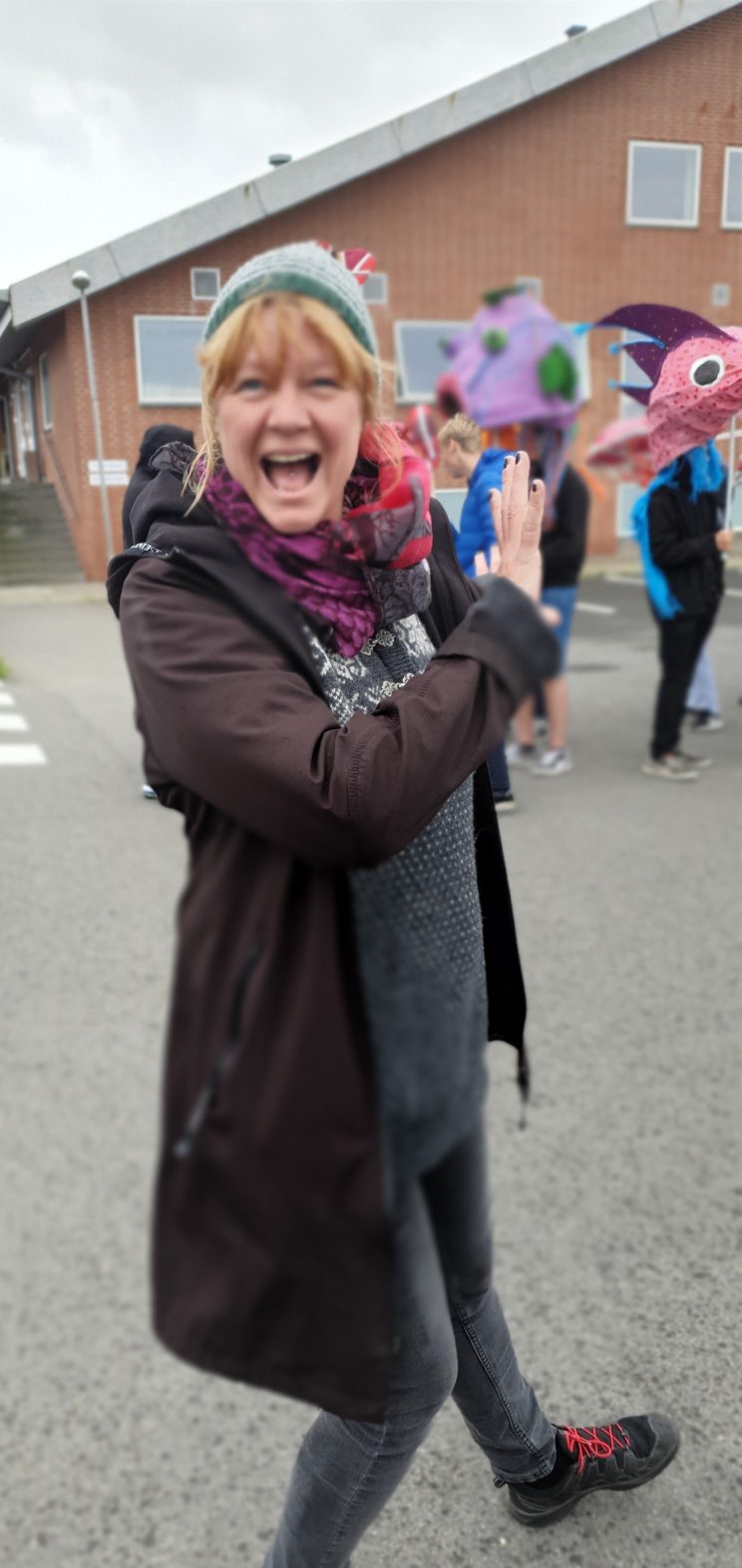
Pollution of the sea was the main theme of the parade for the children. The masks and emblems they made for the parade represented different animals of the sea whose stomachs were filled with plastic garbage.
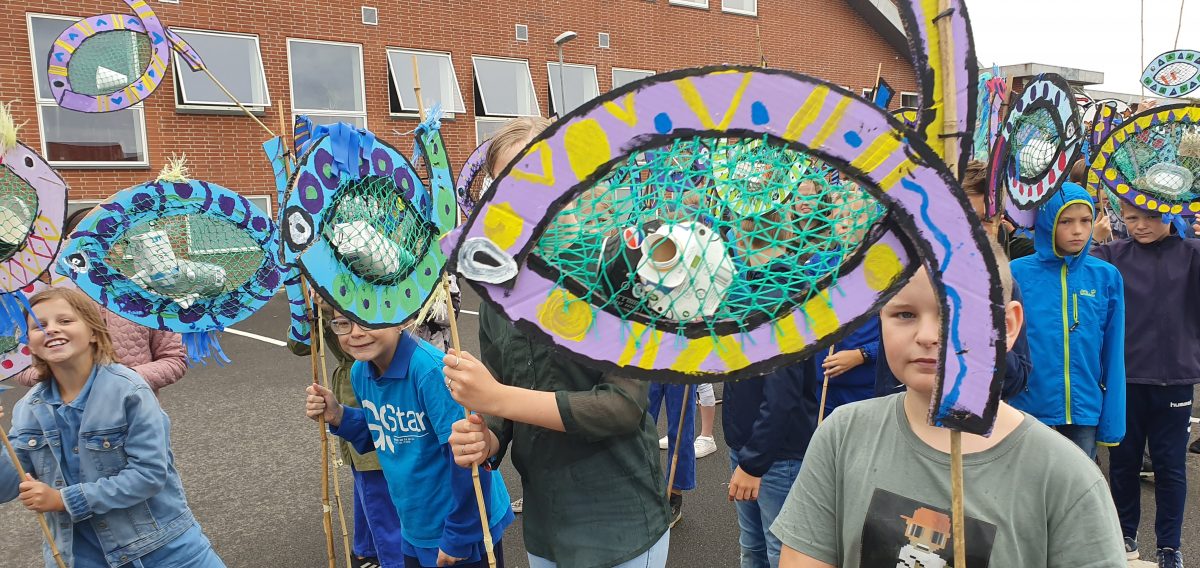
The parade itself walked for about a kilometre, down from the hill, across the bridge, and to a port pier (where the Winds later performed UR-NAT). It was very different from the one in Ringkøbing, mostly because it was more of a performance-parade, which the spectators, standing along its route, were supposed to watch as it passed by, rather than participate in it, like they did during the “Cultural River” in Ringkøbing.
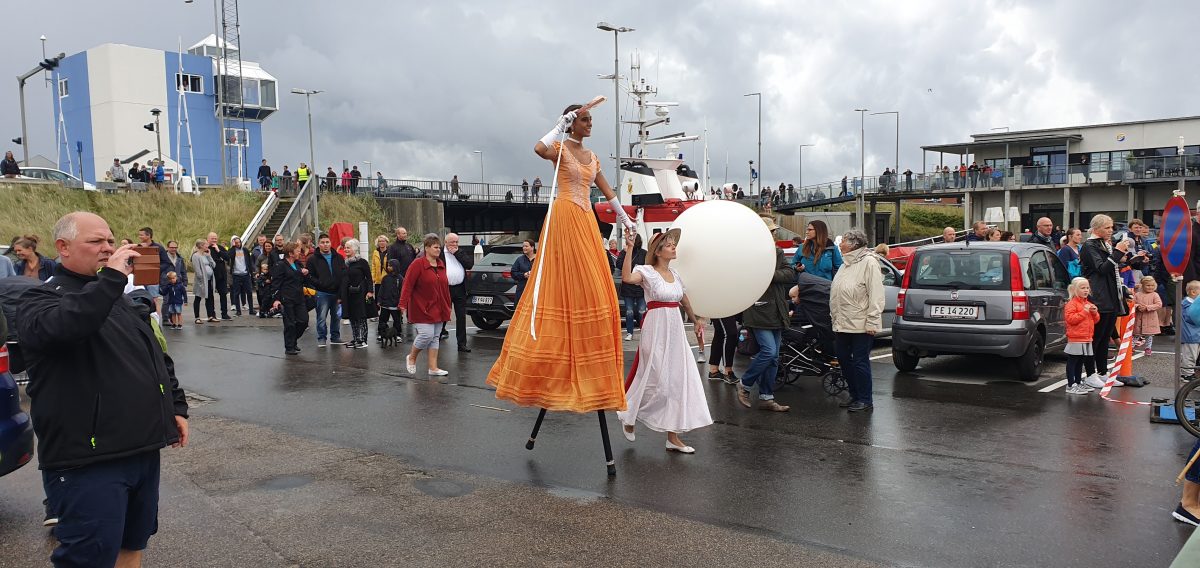
It was also different because of the very different visions the two directors had, Leo Sykes in Ringkøbing and Miguel Utreras in Hvide Sande. From almost the same elements, Leo created the story of Neptune, Iemanja, and the Mermaid, while Miguel made a Latin American cosmogonic ritual. The spectators don’t know those stories of the directors standing behind the parades. Instead, they will make their own stories in their minds, which, in our turn, we will never hear.
UR-NAT NOMEN ATQUE OMEN
When you give an outdoor performance a title, which is an anagram of the Danish word for “nature”, Nature will inevitably intervene. During our stay in the Ringkobing area, we performed it three times, in three different locations.
One was at the port in Ringkøbing, on a very windy day, with very dramatic clouds above the fjord as the backdrop, and special sound effects made by the wind turning the sailboats’ shrouds into a harp, accompanied by the wailing of the gulls.
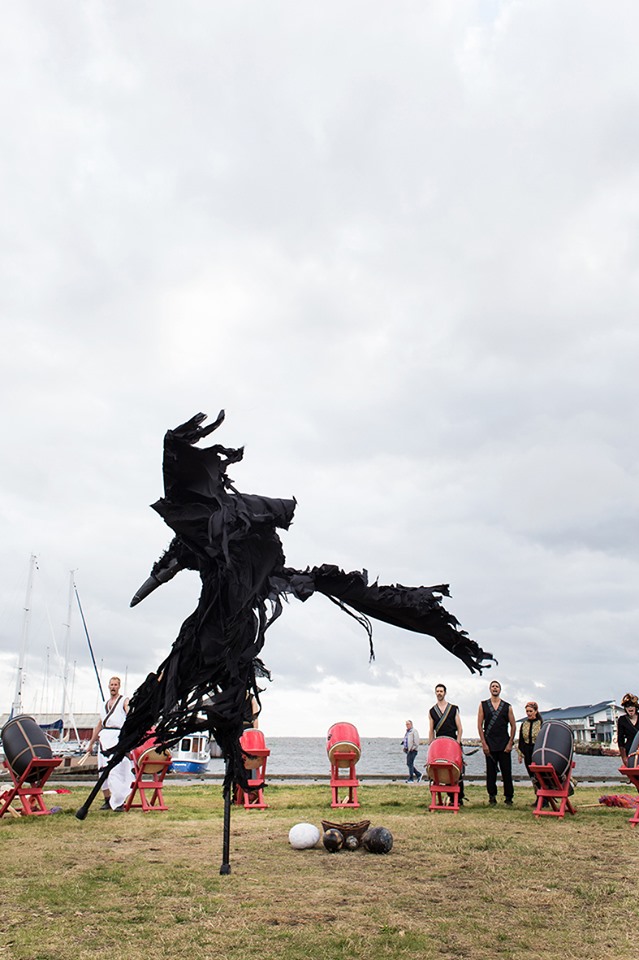
Another was in a small town called Lem, just before sunset, where it was the sun, coming almost horizontally from behind the actors, which designed the lights for us.
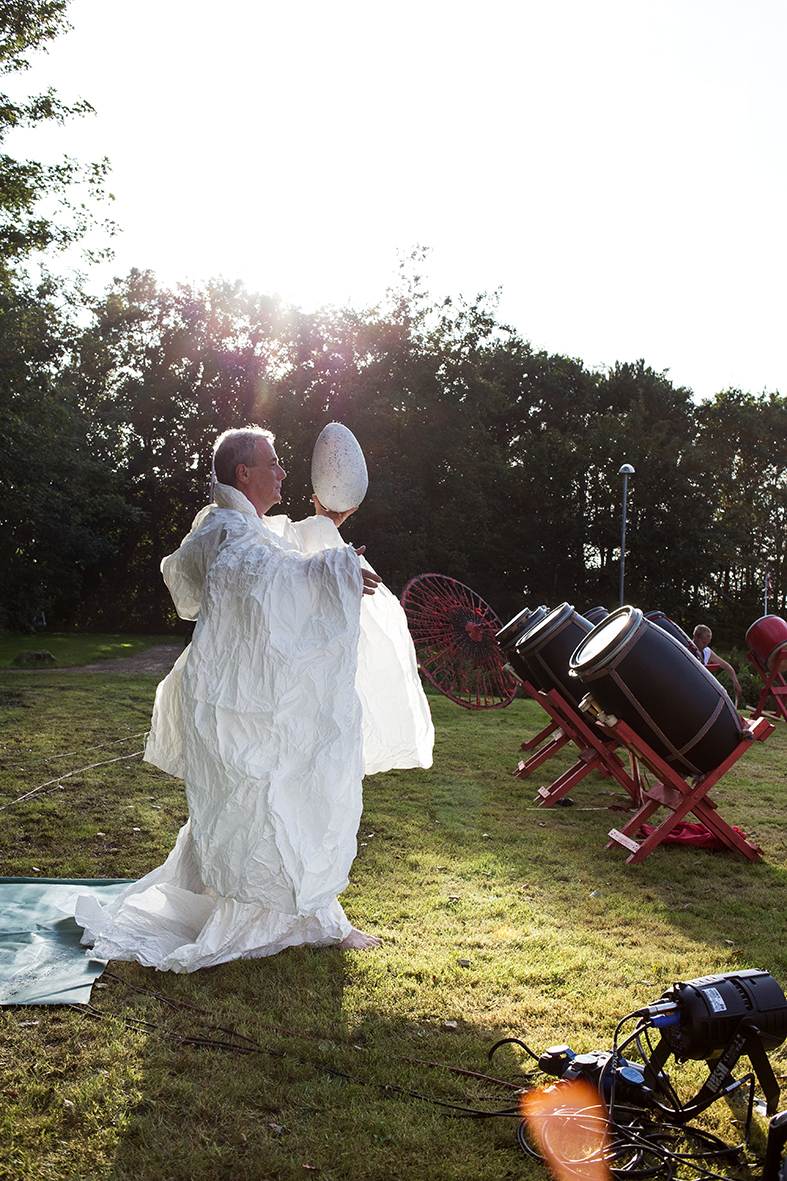
The last performance was after the parade in Hvide Sande, where the poor Winds were almost swimming in the puddles made by the pouring rain.
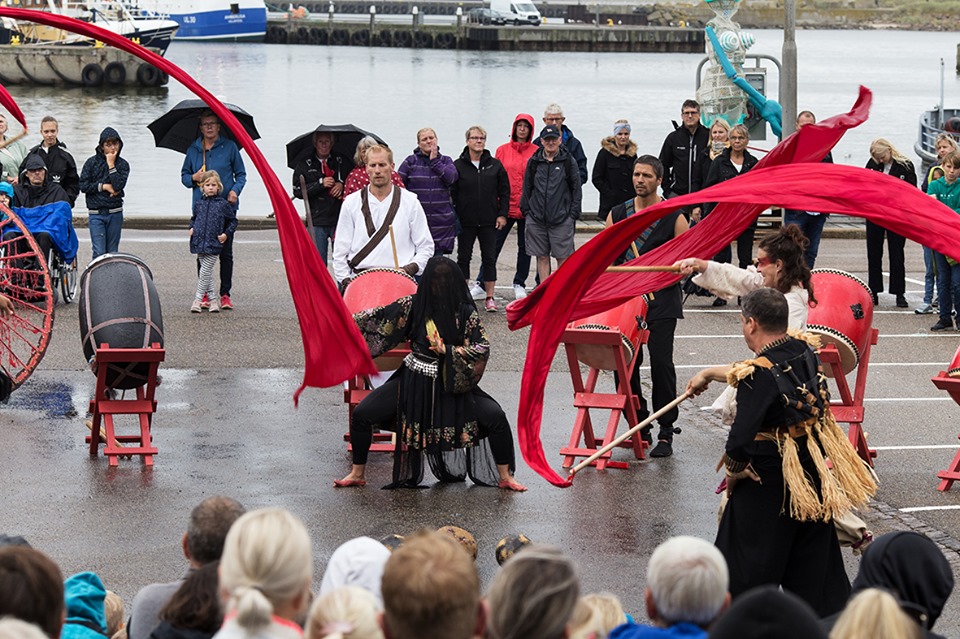
TO BE A LOCAL THEATRE
A post to celebrate Teatret OM
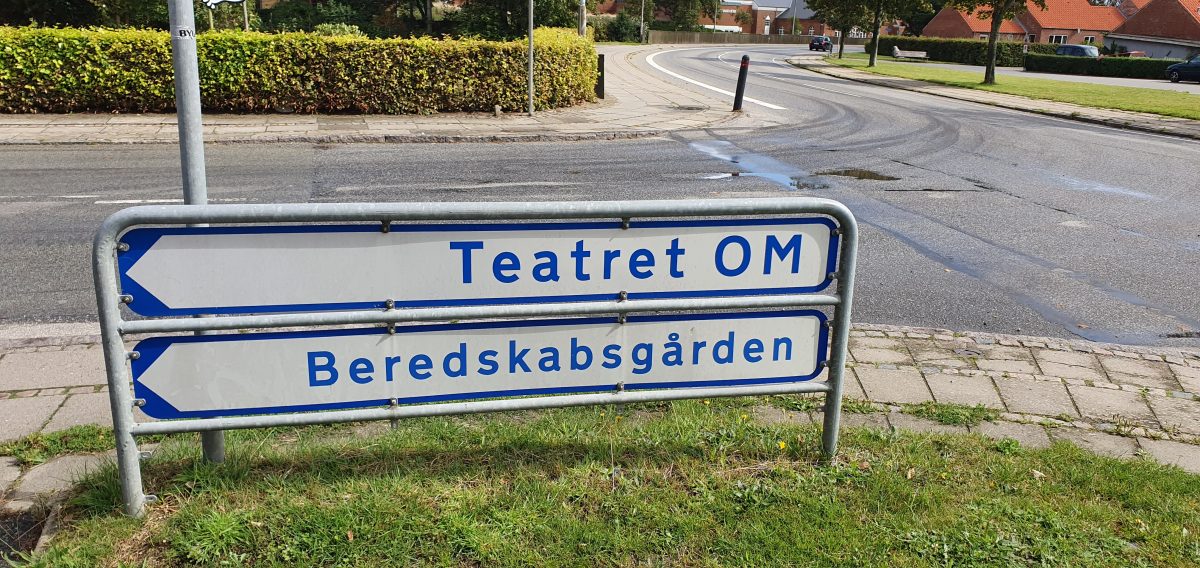
On our last day in Ringkøbing, a lunch celebration of Teatret OM’s 30th. anniversary took place. The volunteer cooks became the guests of honour, along with a group of actors from Odin Teatret, family members of Teatret OM actors, The Bridge of Winds, and all the people who cooperated on the production of the anniversary festival, ranging from the invited directors to the OM office staff.
There were songs for every group of contributors. Iben sang for the volunteers, Om sang for the directors and assistants, the Winds sang for the accountant, and Miguel Utreras sang for the OM. The project coordinator, Søs Banke, who made it all possible against all obstacles, which included the forces of Nature, was especially celebrated: the Winds not only sang for her, they also carried her around the room in their arms. Then she surprised everybody with a song, sung in her amazingly strong and beautiful voice. Hey, Søs – ever thought of joining The Bridge of Winds?
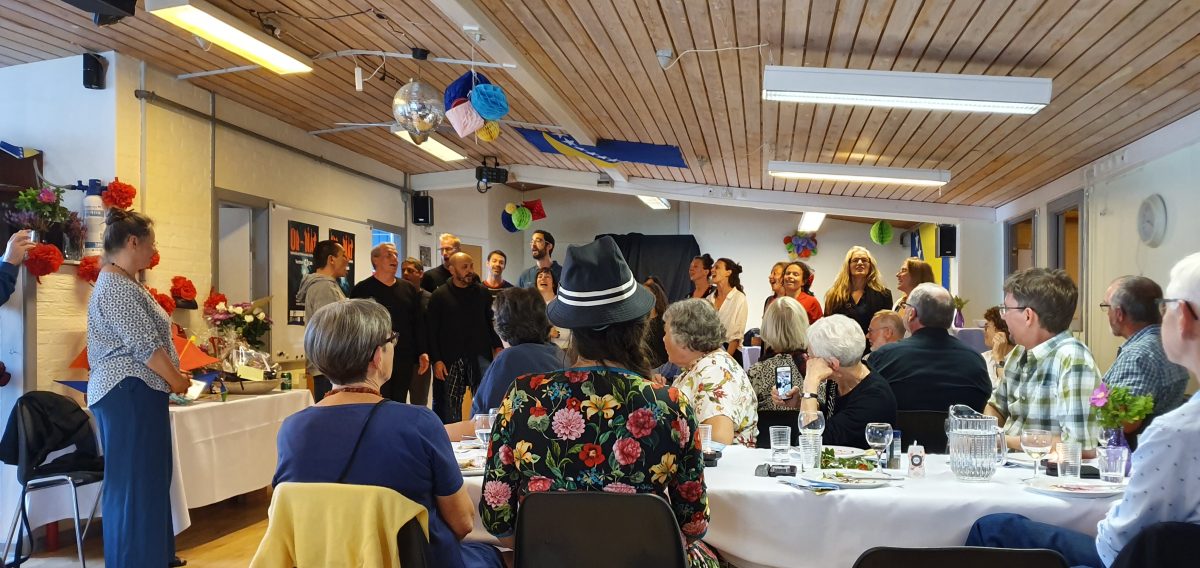
There was a table with gifts (the boat with the rainbow sails is from the Odin), the tables were set with napkins featuring pictures of the local landscape, and the food was as delicious as it was beautiful.
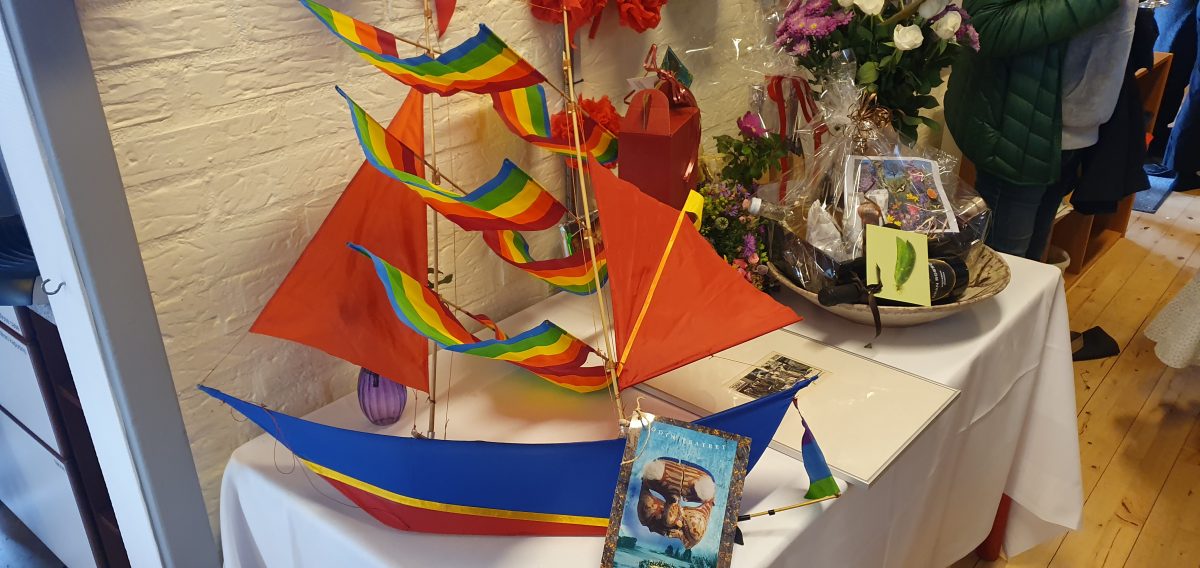
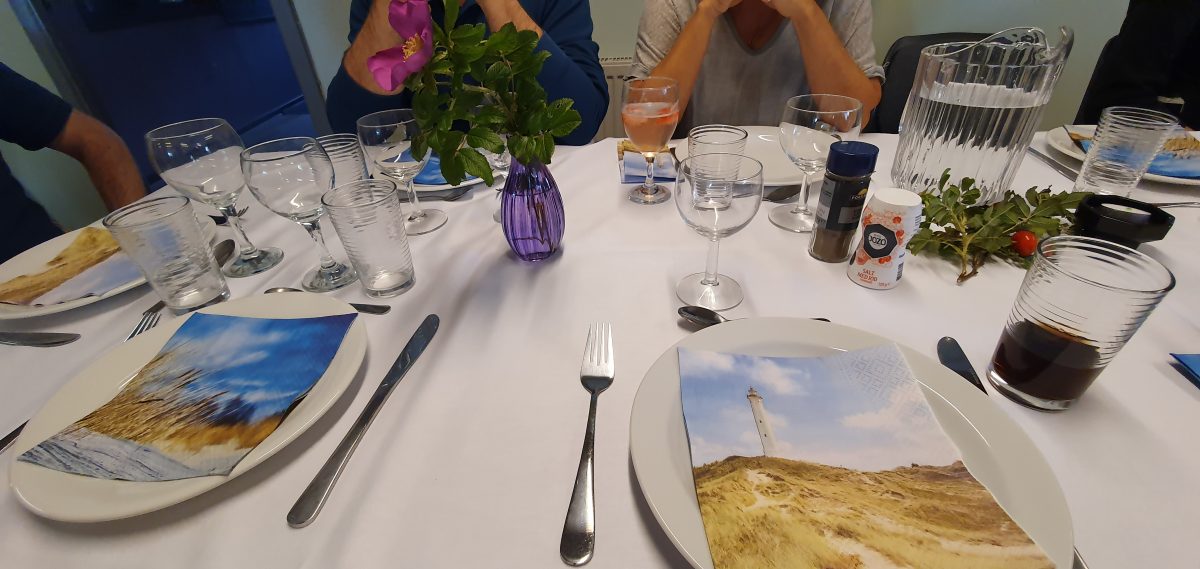
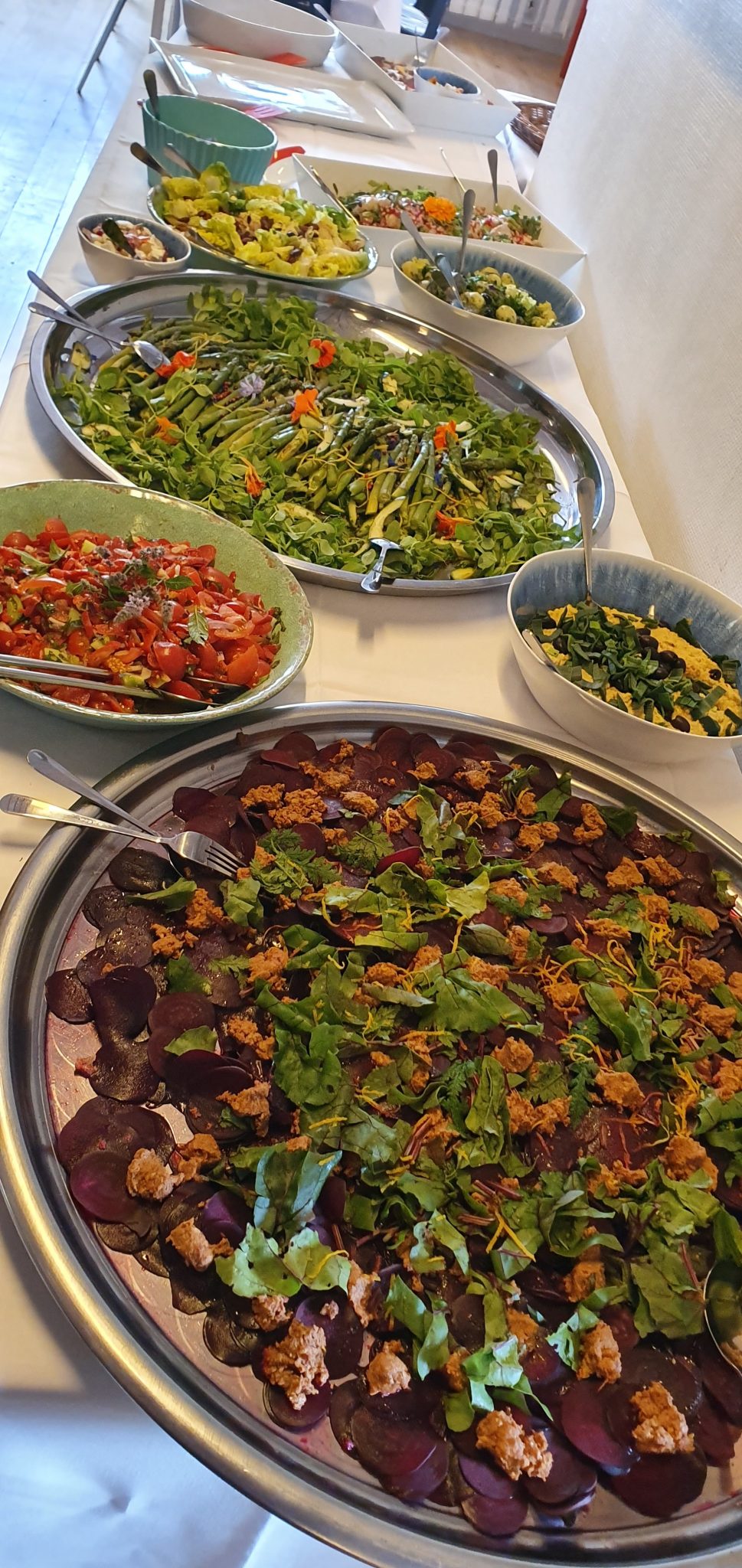
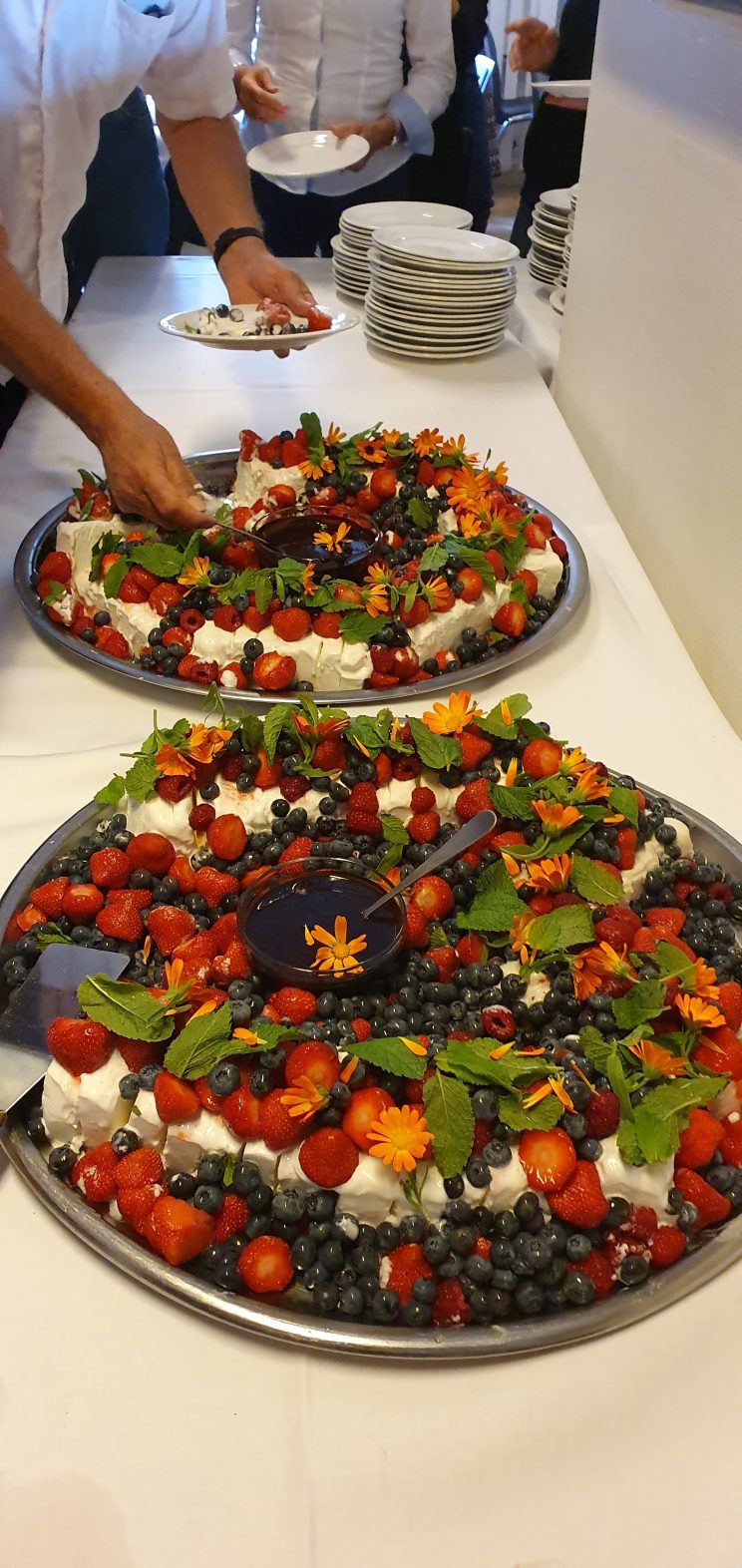
There was also an “off-party” outside, with songs from Jan Ferslev and Petra Banke (Søs’ daughter), and everybody dancing in the sun, which decided to finally show its face on the day our festival of outdoor performances was over.
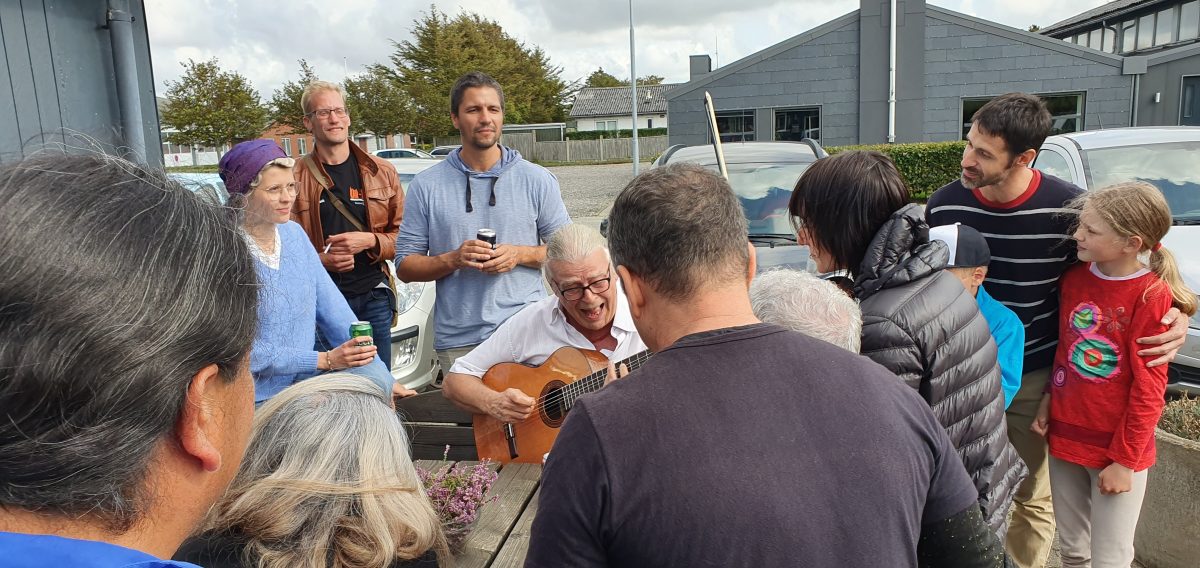
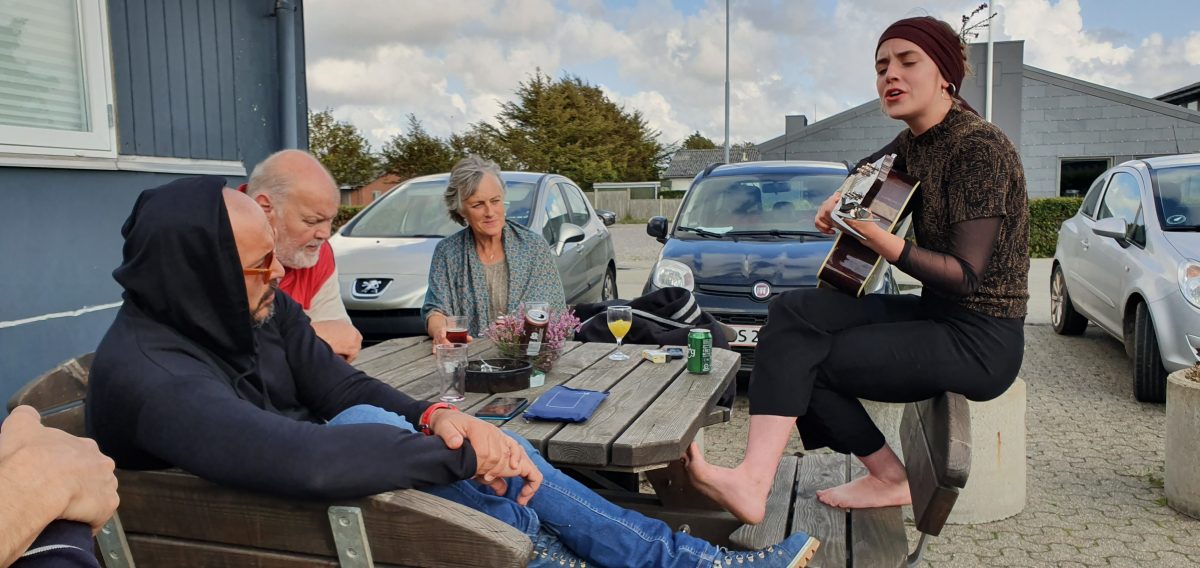
The festival, organized to celebrate Teatret OM’s 30th anniversary, was entitled “UR-NAT, International Performance Art Festival”, and involved six theatre ensembles from all over the world. Since OM is a regional theatre, the performances were presented in six different towns across the Ringkøbing-Skjern Region.
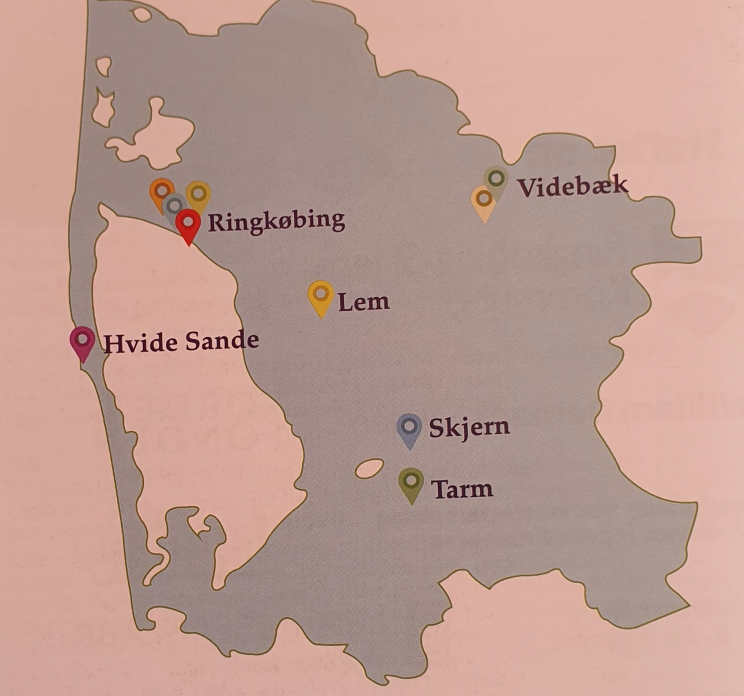
Let us stop for a moment at the small town of Lem, one of the local communities Teatret OM has been working with in the area. The festival event there was located in a park, on a small pond. It involved three performances (a clown performance by the Cuban Teatro Tuyo, a juggling show by the Scottish-Spanish Gandini Juggling duo, and UR-NAT). It was organized like a village feast and there was everything there: local firemen, a flea market, food trucks, ladies selling home-made cake (yummy, tried it for you!), a stand with (very frightened) exotic animals and (stressed) bunnies children could pet (or, rather, squeeze), and a big tent, decorated with cute little flags painted by children, covering a beer bar.
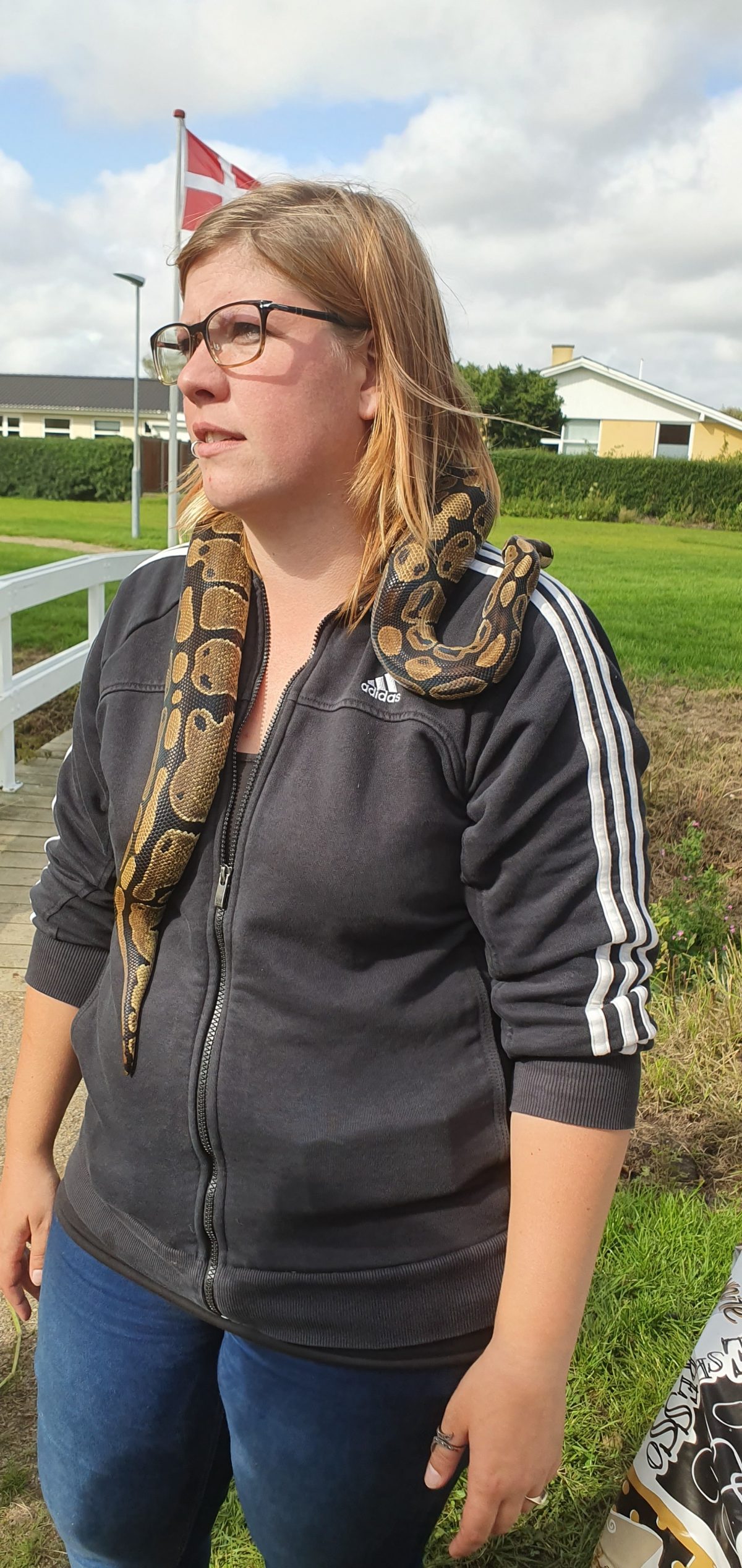
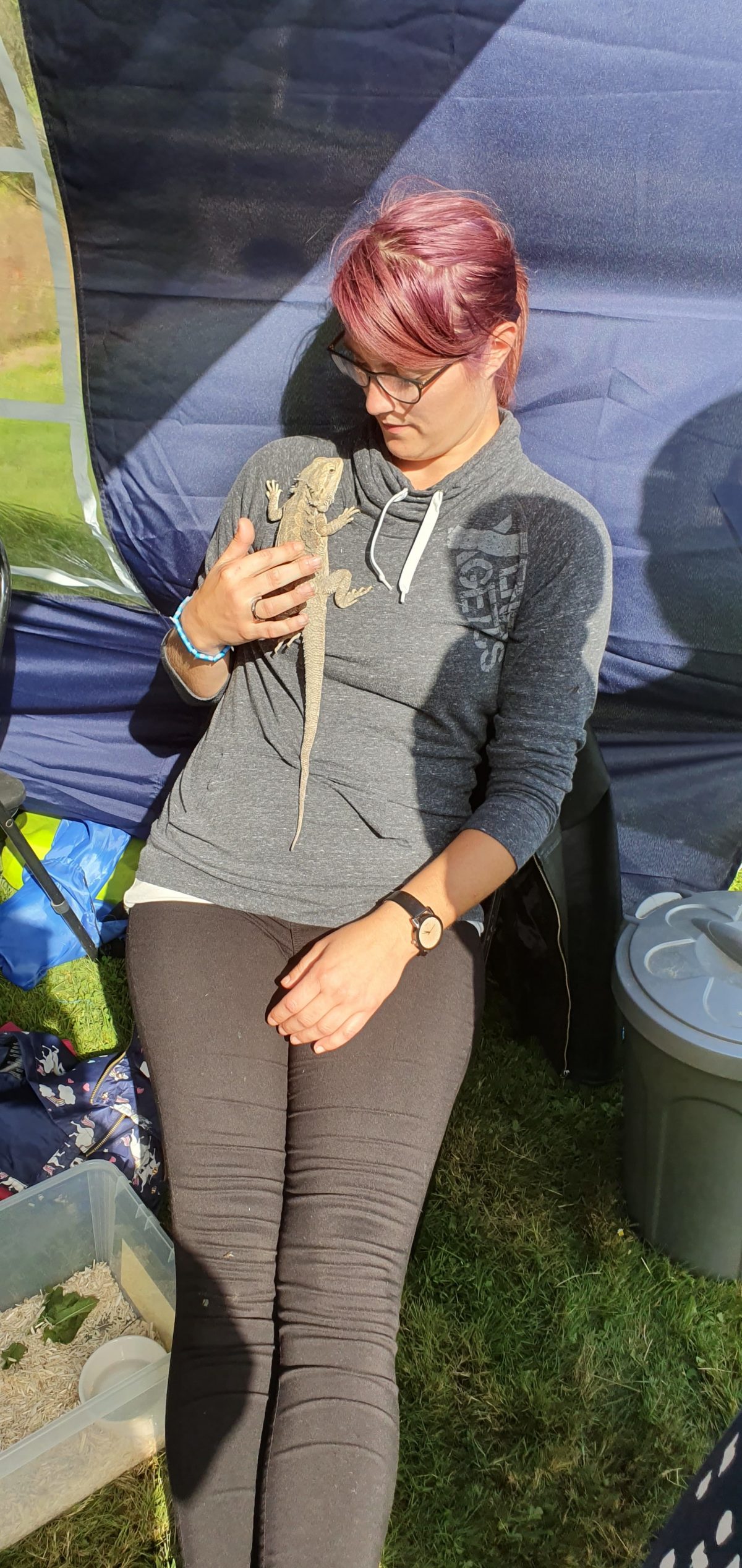
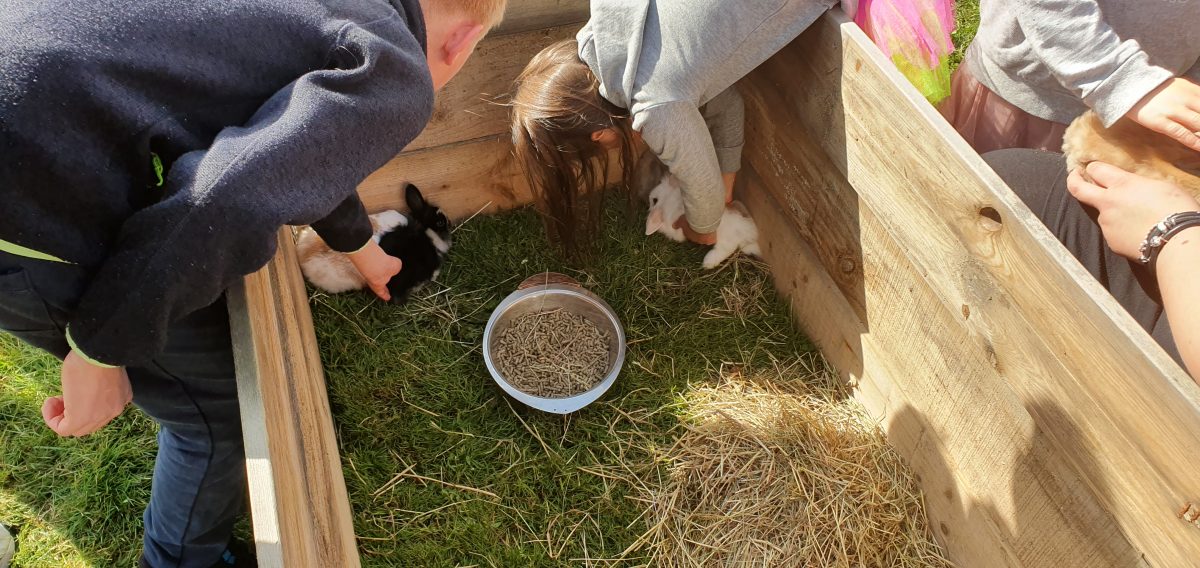
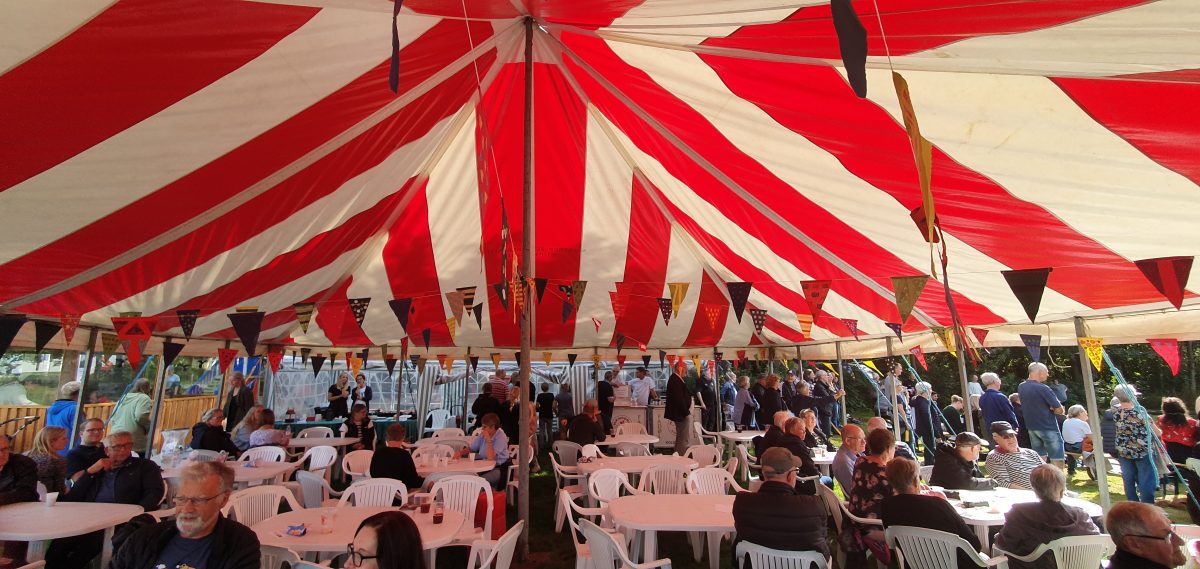
Amidst all these festivities, the Winds made some interventions with their street characters. Annemarie Waagepetersen, Tippe Molsted, and Iza Vuorio as a hilarious trio singing folk songs, Miguel Jerez with his Toucan character, Sofia Monsalve on stilts, Signe Thomsen and Lina Della Rocca with a workshop for children, and Sandra with her clown character, Spugna (meaning a drunkard).
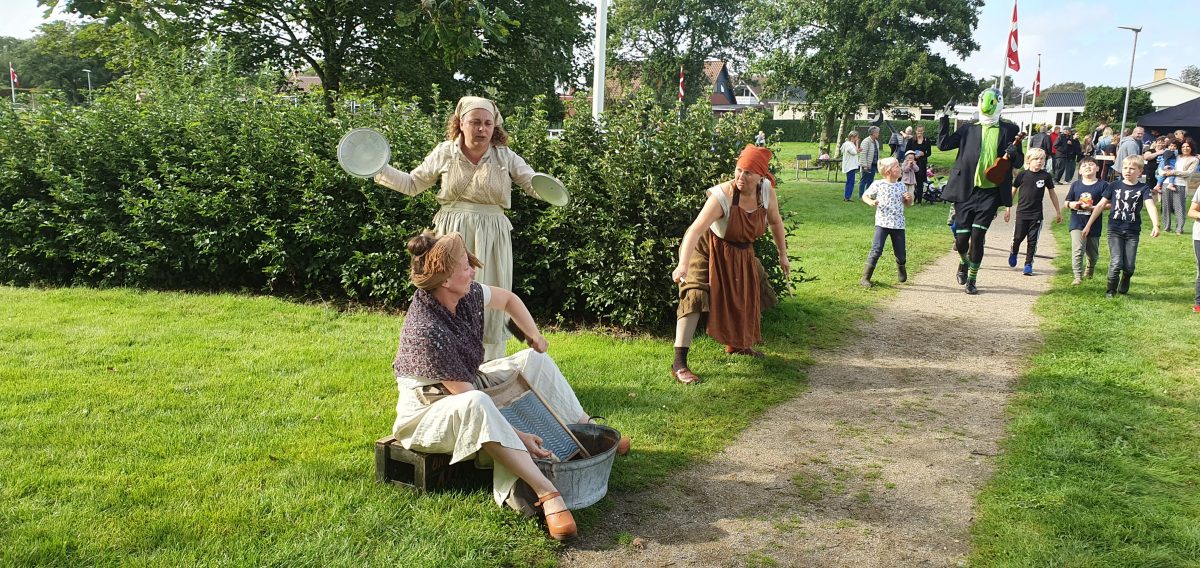
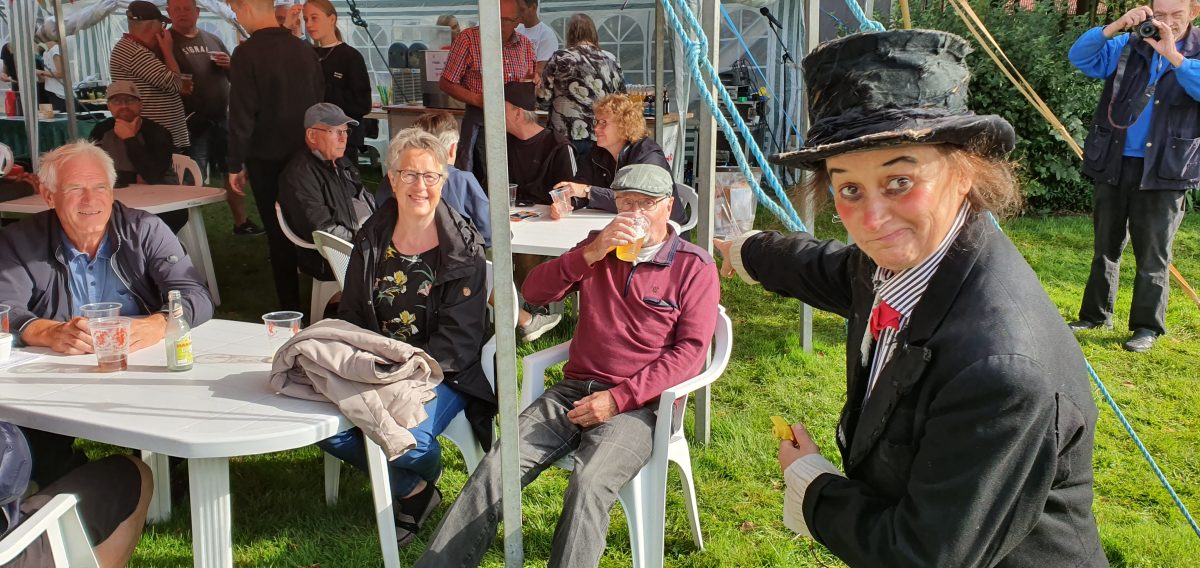
Adriana La Selva and Marcos Koslowski found a perfect spot – on the other side of the pond, away from all the festivities – for their fishing scene, which became very romantic among the reeds on the pond.
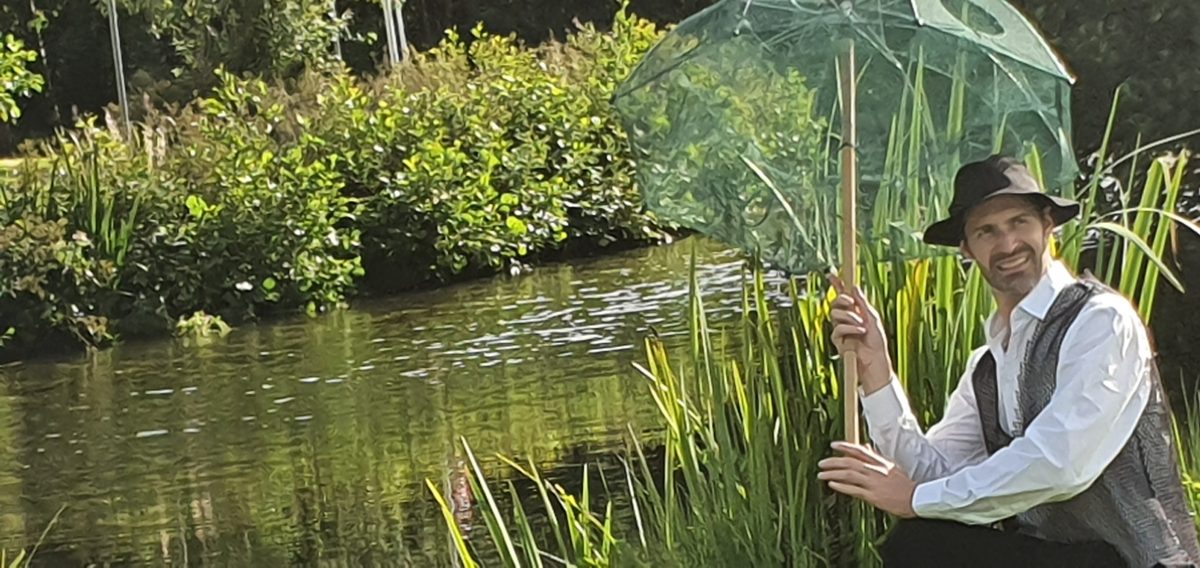
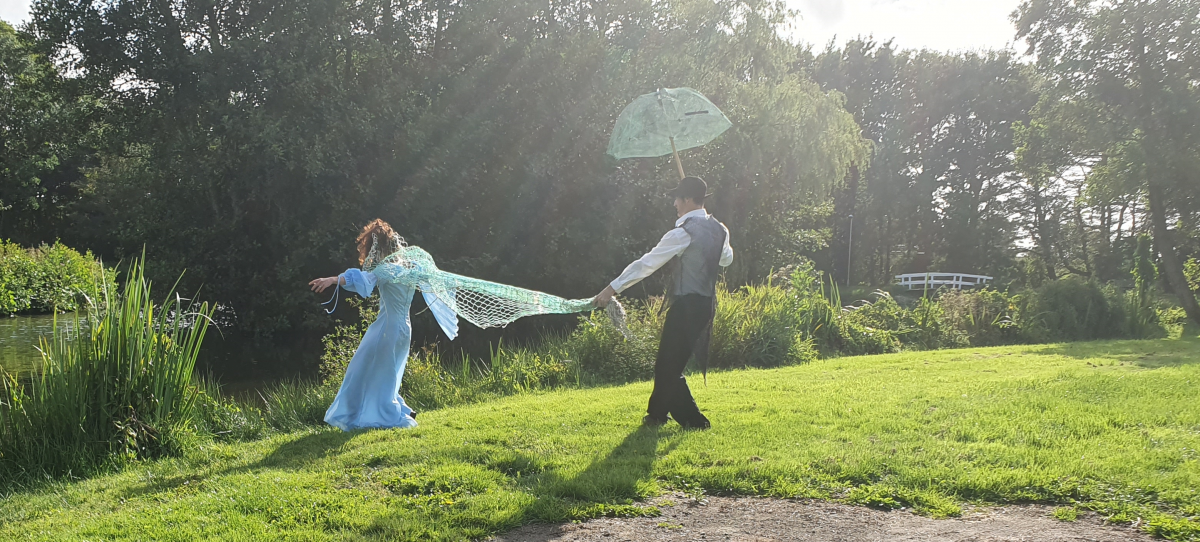
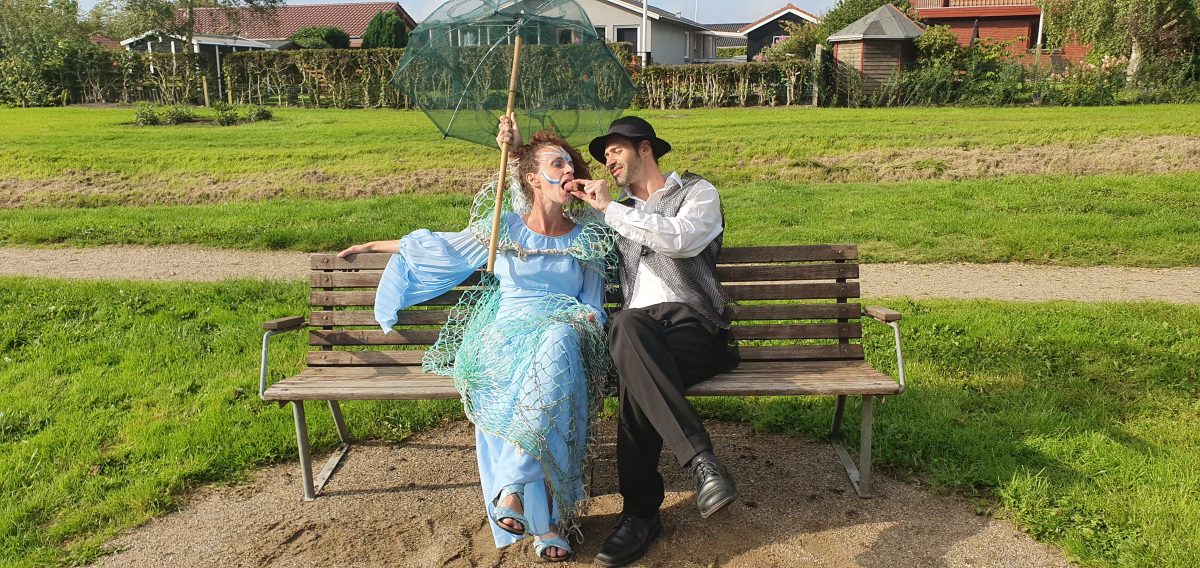
They even got one spectator.
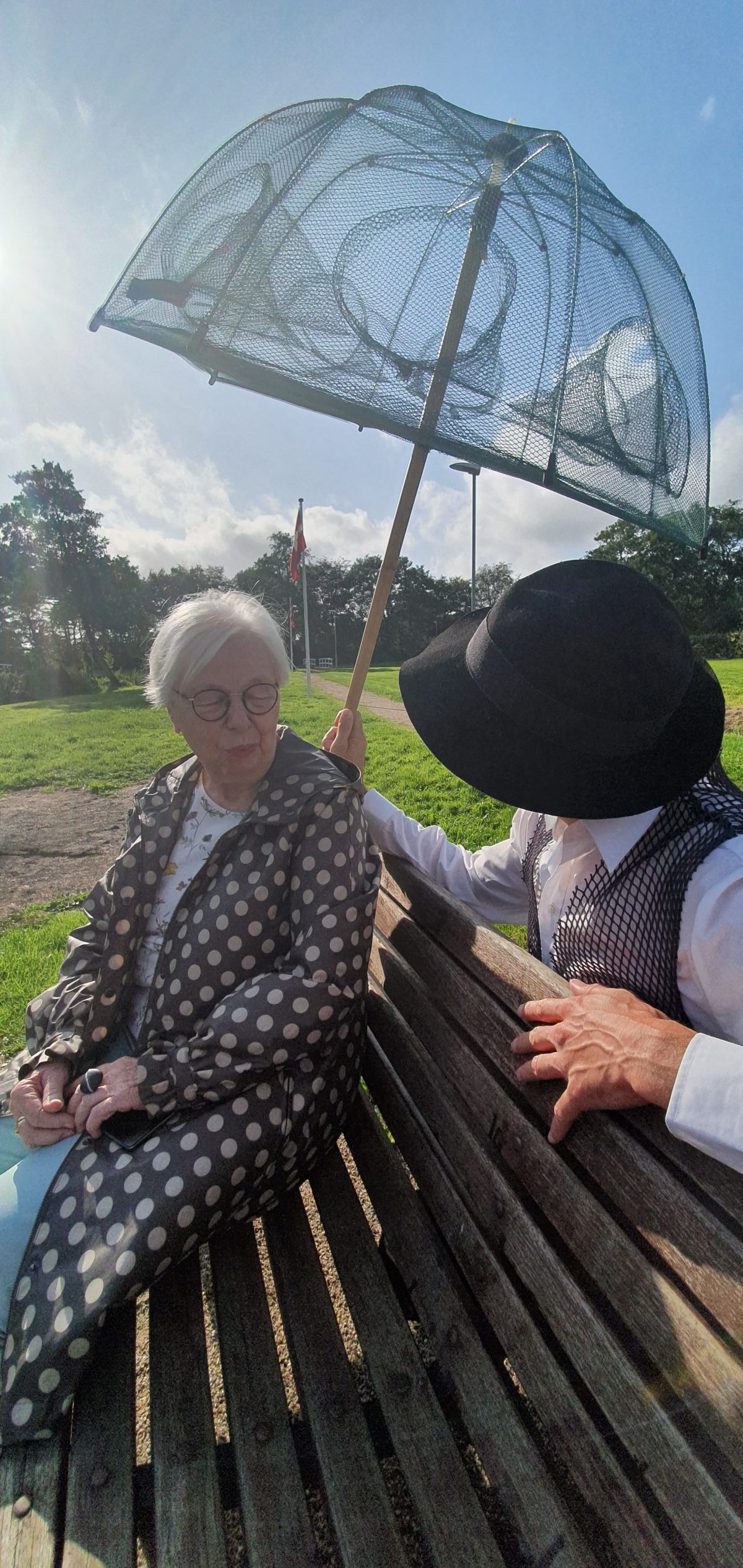
As it turned out, the lady used to organize theatre performances in the town of Lem years ago. But nobody came to see them. So she came to see how we succeeded in that today. And it was very obvious that the theatre interest had increased very much during the years Teatret OM has been here.
Teatret OM is a Regional Theatre in the largest municipality in Denmark. This area didn’t have a resident professional theatre before, so the work Teatret OM is doing, is planting theatre seeds, and we can see how the seeds planted 10 years ago, when the Winds were here last time, have started to grow. Many more people came to the different performances and events and are expressing their support for the theatre.
Teatret OM must persuade the local politicians to renew their Regional Theatre contract every four years. Next time they will have to do it, is in 2020. Let’s hope the anniversary festival and the presence of The Bridge of Winds has been helpful in that, and the OM will continue to bring art and culture from all over the world to Ringkøbing-Skjern Municipality for many more years.
More hope comes from the supportive words of Per Høgh, the man responsible for culture at the Ringkøbing municipality, who was telling us how grateful he was to Teatret OM for “taking us to remote worlds, like the Arctic (in the performance “79’fjord”) or the belly of a whale (with “Song of the Whale”), for bringing the big wide world into the small local towns (with the festivals and The Bridge of Winds), and for going out of their theatre room: to schools, nursing homes, the woods, the sea, and the lighthouses.”
The lighthouses were a reference to the OM’s newest production, “Lighthouses – Stories from the Sea”, which has been performed about twenty times at different lighthouses in the area. They also performed it especially for the Winds, to see on the morning before the anniversary lunch. What a gift!
It is a site-specific performance, in which the spectators follow the actors around the landscape surrounding local lighthouses, and listen to stories of the sea-shore: of shipwrecks, plundering, sea rescues, and immigration.
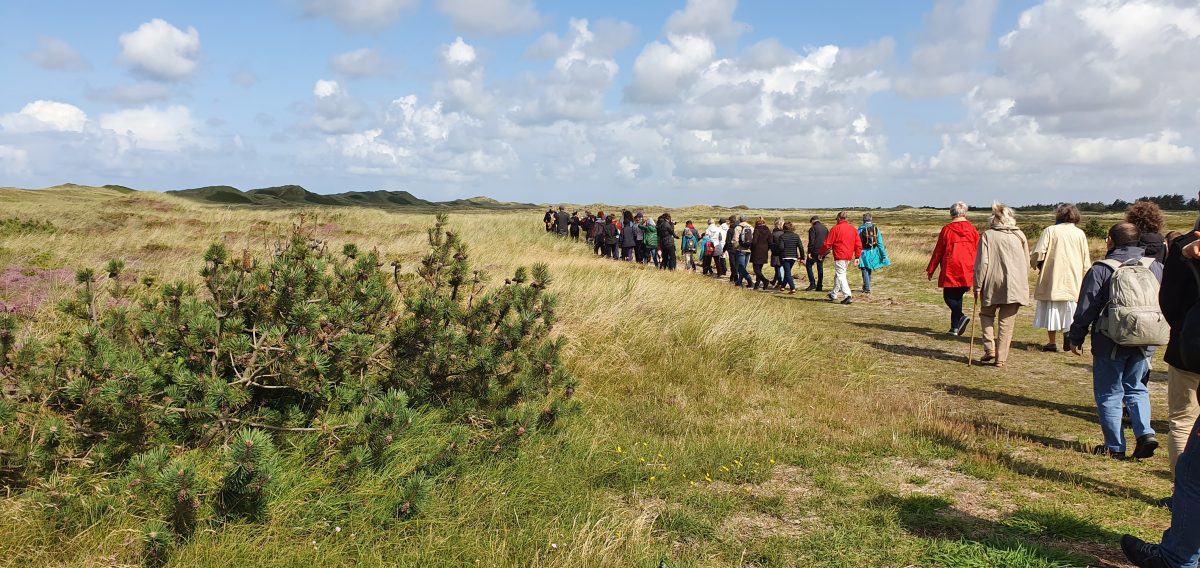
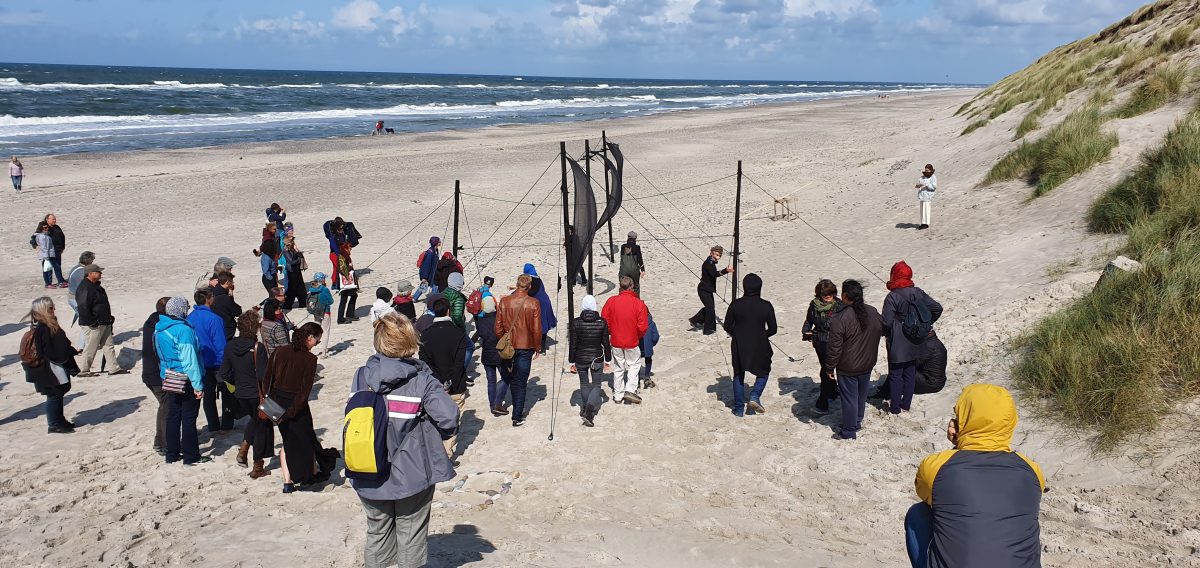
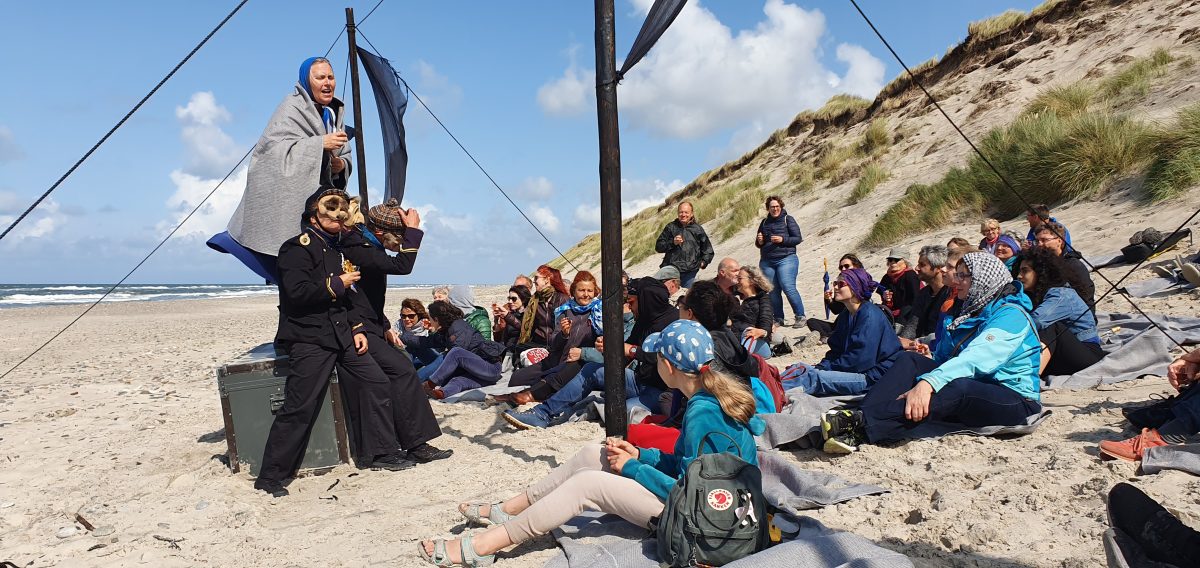
The dune landscape was unbelievably stunning, many comical elements of the performance were absolutely hilarious, but – among all this joy and beauty and fun – there was a shadow of fear, when, locked in a boat-shaped fence overlooking the beach, we suddenly heard the words “passport control” and contemporary stories of people fleeing from their country, allowed to take with them only their passports and the clothes they were wearing. The fear creeped in from the combination of our memory of Holocaust and ethnic cleansing stories, with childhood memories of going to the beach, seeing the first glimpse of the sea from the path in the dunes, and wanting to run to it as fast as you could. But nope. Passport control.
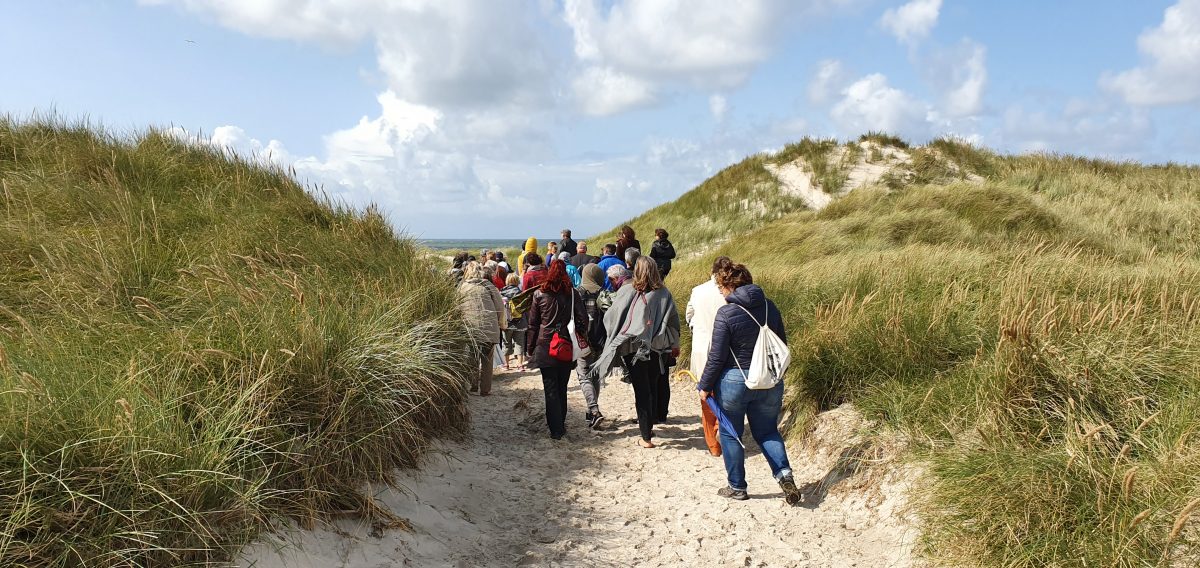
The power of theatre to evoke that kind of emotional response in the spectators makes it possible for it to involve them in important contemporary issues and problems on a much deeper level than the speeches of politicians or any publications by scholars or the media. A local journalist cooperating with Teatret OM, Jørn Verner Stendorf, called it a ”mental support” that the theatre is giving to those issues. And, as Miguel Utreras put it: “The children who participated in the parade in Hvide Sande, for which they had prepared their fish emblems full of plastic, will always remember the emotional impact of participating in this movement to stop the pollution. And perhaps they will build a better world than we have.”
The children of Hvide Sande are a nice “segway” to another trait of being a regional theatre in a meaningful way – reaching out to spectators who normally do not go to the theatre. Neither the elderly inhabitants of the nursing homes, the 300 kids from Hvide Sande with their parents, the refugees, nor the inhabitants of all the remote small communities the Winds and other artists invited to the festival performed for, would come to Teatret OM’s space in Ringkøbing to see a performance. So Teatret OM comes out to them. And took the Winds along this time.
A good example is the way the Winds’ Concert was used, performed at three very different locations, none of which being a traditional theatre stage or a concert hall. The first one was a newly built local “centre for development and innovation”, named Innovest (http://www.innovest.dk/), which hosts over a dozen small businesses, as well as conferences, exhibitions, and educational events. The Winds were a little surprised to perform there, but it was a way to reach new audience (as well as give the spectators a brief but wonderful artistic experience, as the acoustics in the place was amazing).
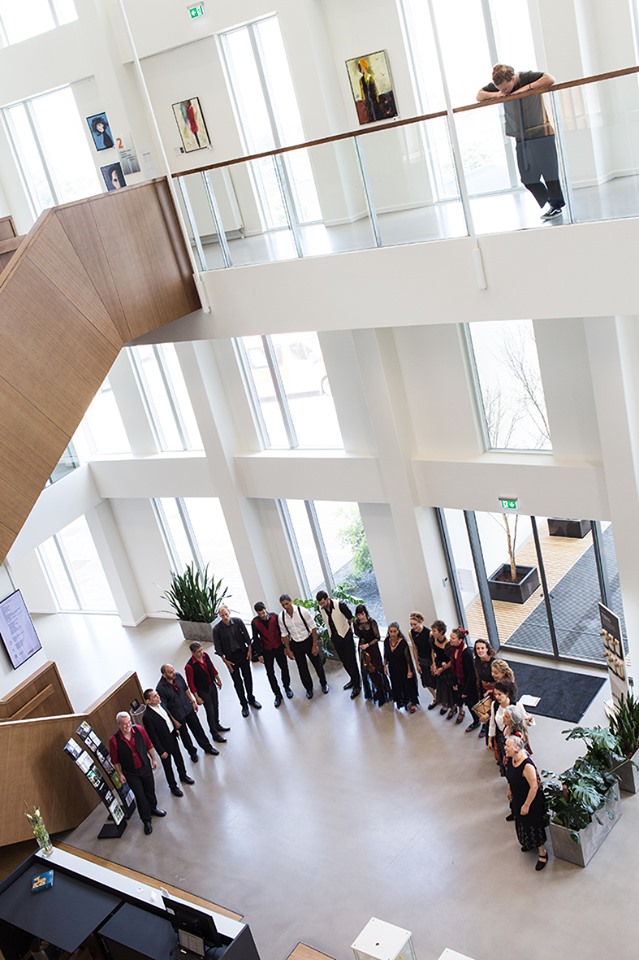
The second location chosen for the Concert was a church in the town of Videbæk, 23 km away from Ringkøbing. There were at least two hundred people in the audience and they gave the Winds a standing ovation. Probably at least half of them, next time they hear about a performance at Teatret OM, will get in their car and drive those 23 kilometres to Ringkøbing. And it is not about boosting Teatret OM’s popularity, it is about making more people actively participate in cultural events in a region where people are not so eager to participate in them.
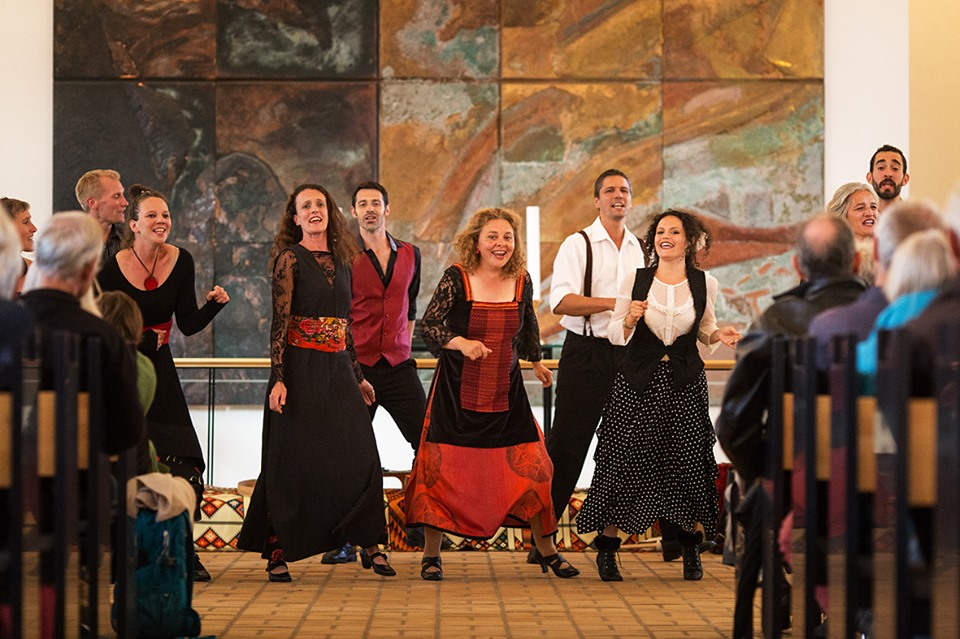
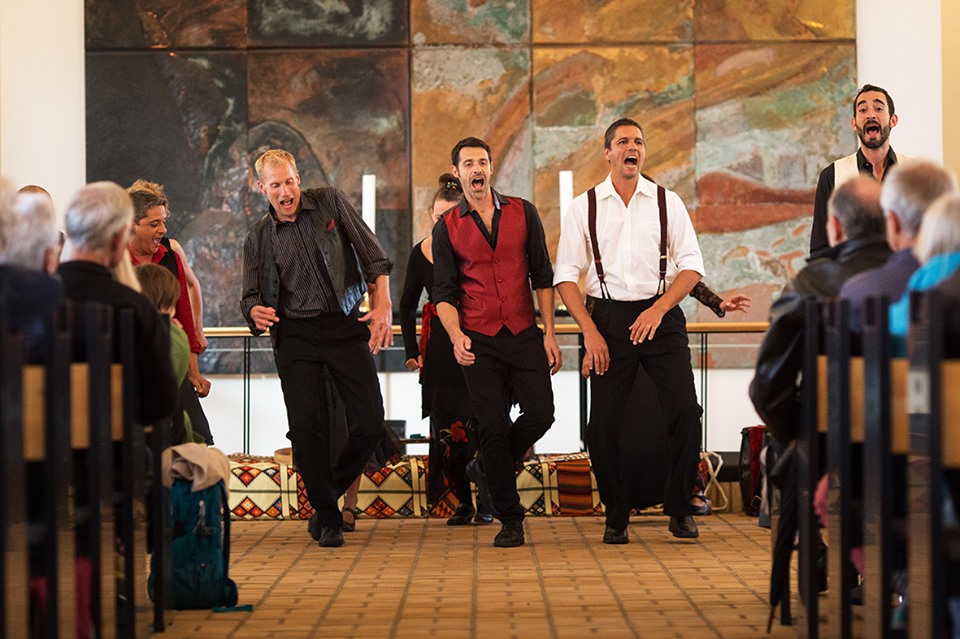
The third place where the Winds performed their “Voices in the Wind” concert, was a parking lot between a school and blocks of flats inhabited by immigrants (a “Danish favela” as it was explained to the South American Winds). But when we got there, there was nobody waiting for us… Yes, well, of course, immigrant communities are quite closed. So the Winds used their street performance skills and went among the buildings with songs and instruments, inviting people to come down to the concert, in all their different languages.
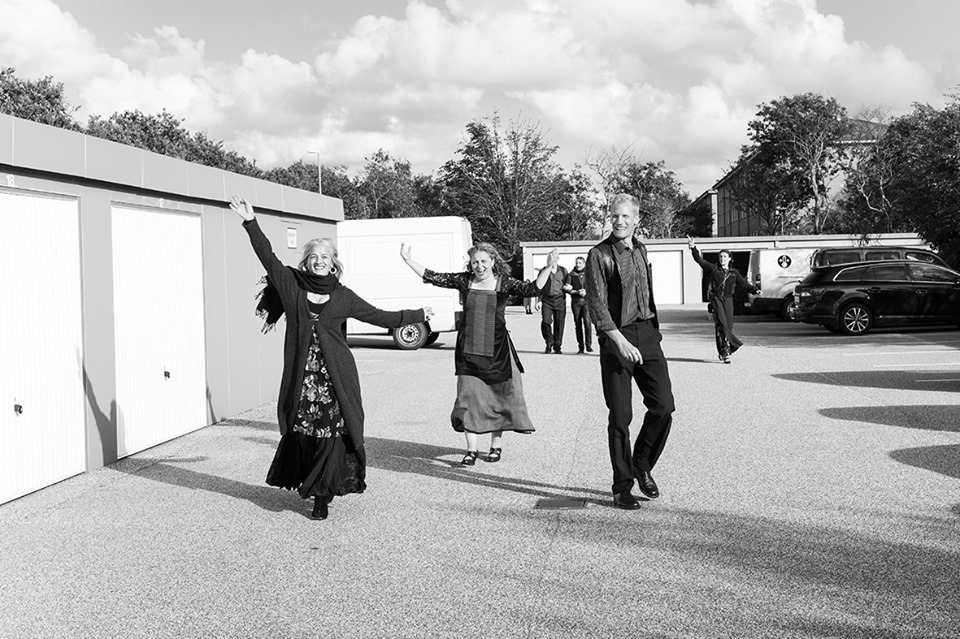
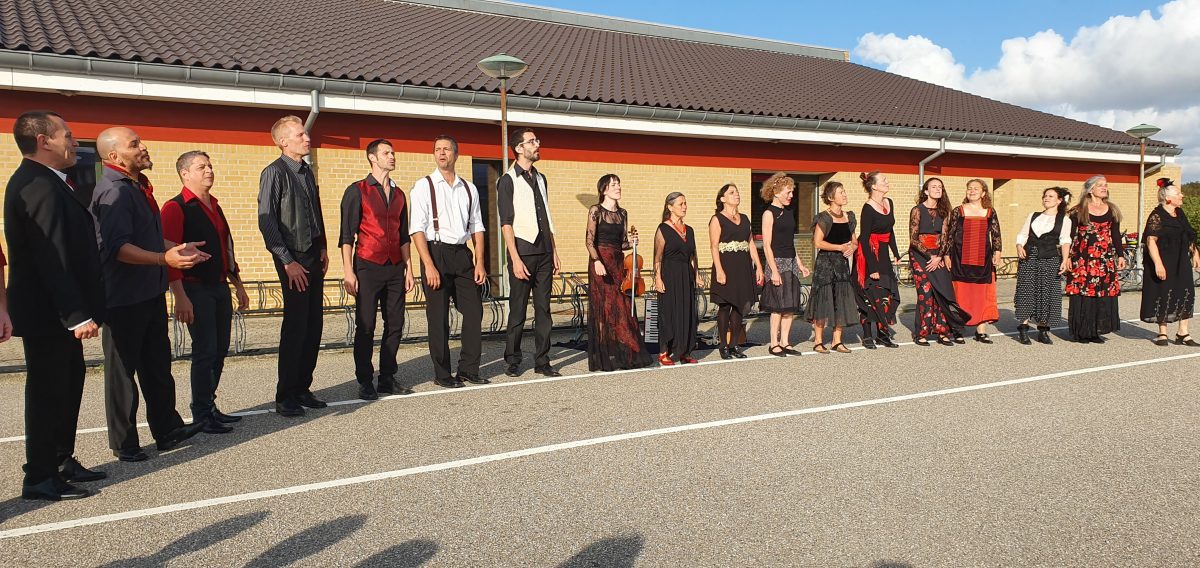
This whole stay with Teatret OM was also a wonderful lesson to all the members of The Bridge of Winds, on how to make your theatrical presence meaningful and going way beyond merely presenting your artistic achievements. At the end, the Winds had a meeting discussing the future work of The Bridge of Winds. Should it be more focused on developing the artistic research and the training, which is the core of the group and – as Tatiana Cardoso put it – can take the participating actors into the zone of the endless and the infinite? Or should it open up even more and concentrate on performances, teaching seminars, making barters, and working with other people. Iben concluded it by saying the training is for the actor to perform and to meet people, and performing is what we are here for as actors.
Katarzyna Kazimierczuk august 23, 2019
